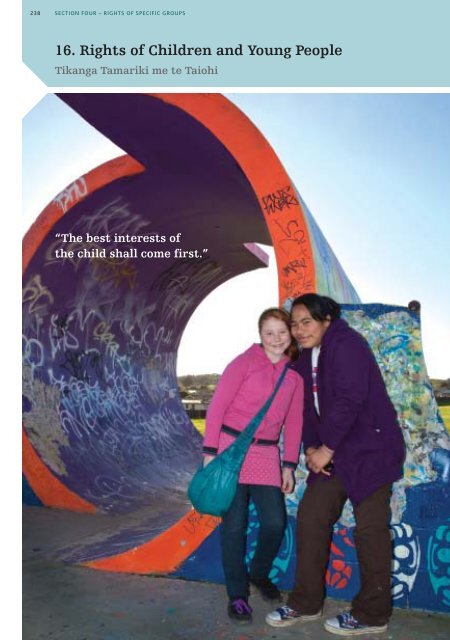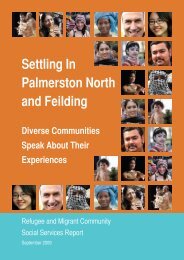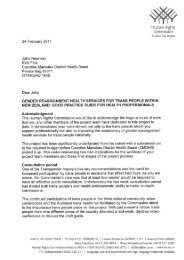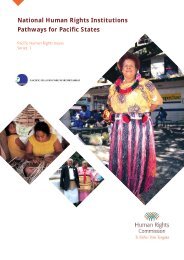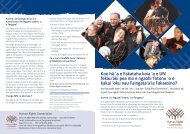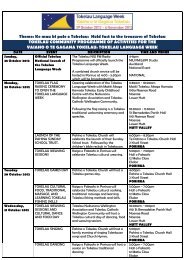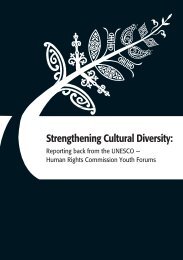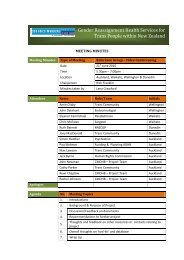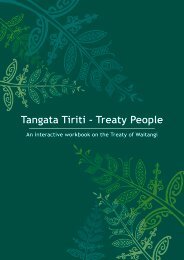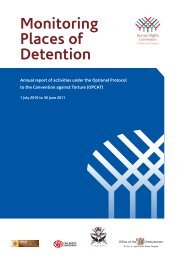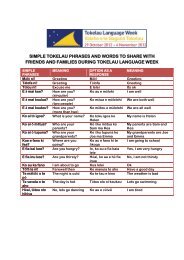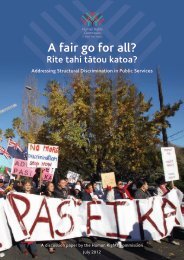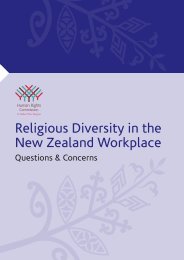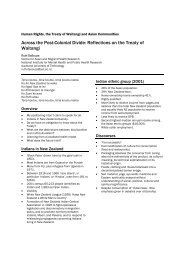16. Rights of Children and Young People - Human Rights Commission
16. Rights of Children and Young People - Human Rights Commission
16. Rights of Children and Young People - Human Rights Commission
You also want an ePaper? Increase the reach of your titles
YUMPU automatically turns print PDFs into web optimized ePapers that Google loves.
238<br />
SECTION FOUR – RIGHTS OF SPECIFIC GROUPS<br />
<strong>16.</strong> <strong>Rights</strong> <strong>of</strong> <strong>Children</strong> <strong>and</strong> <strong>Young</strong> <strong>People</strong><br />
Tikanga Tamariki me te Taiohi<br />
“The best interests <strong>of</strong><br />
the child shall come first.”
HUMAN RIGHTS IN NEW ZEALAND 2010 239<br />
The best interests <strong>of</strong> the child shall<br />
come first.<br />
Convention on the <strong>Rights</strong> <strong>of</strong> the Child, Article 3 (edited)<br />
Introduction<br />
Tïmatatanga<br />
This chapter outlines the international <strong>and</strong> domestic<br />
framework for the protection <strong>of</strong> children’s rights,<br />
focusing on key issues <strong>and</strong> developments since 2004.<br />
Overall, most children in New Zeal<strong>and</strong> are able to enjoy<br />
their rights, but they remain one <strong>of</strong> the most vulnerable<br />
groups in our society. There are still significant numbers<br />
<strong>of</strong> children who experience violence <strong>and</strong> neglect, poverty<br />
<strong>and</strong> poor health, <strong>and</strong> barriers to the full enjoyment <strong>of</strong><br />
their right to education. Entrenched disparities are an<br />
enduring feature <strong>of</strong> the situation <strong>of</strong> children in New<br />
Zeal<strong>and</strong>, <strong>and</strong> those under 18 are persistently the age<br />
group most likely to experience poverty <strong>and</strong> hardship.<br />
Furthermore, children remain relatively invisible – their<br />
views are not routinely sought <strong>and</strong> their rights are <strong>of</strong>ten<br />
not explicitly or adequately considered in policy <strong>and</strong><br />
decision-making.<br />
WHAT ARE CHILDREN’S RIGHTS<br />
<strong>Children</strong> <strong>and</strong> young people (all human beings under the<br />
age <strong>of</strong> 18) have the same basic human rights as adults.<br />
<strong>Children</strong> also have specific human rights that recognise<br />
their special need for protection.<br />
<strong>Children</strong>’s rights are commonly viewed as falling into<br />
three categories: provision rights, protection rights <strong>and</strong><br />
participation rights. Provision rights include the right to an<br />
adequate st<strong>and</strong>ard <strong>of</strong> living, the right to free education,<br />
the right to adequate health resources <strong>and</strong> the right<br />
to legal <strong>and</strong> social services. Protection rights include<br />
protection from abuse <strong>and</strong> neglect, protection from<br />
bullying, protection from discrimination, <strong>and</strong> safety within<br />
the justice system. Participation rights include the right<br />
to freedom <strong>of</strong> expression <strong>and</strong> the right to participate in<br />
public life.<br />
<strong>Children</strong> live, learn <strong>and</strong> grow, not in isolation but as part<br />
<strong>of</strong> families, whänau <strong>and</strong> communities. Even though they<br />
are autonomous rights-holders, children – particularly<br />
younger children – are dependent on others (for example,<br />
parents or teachers) to give effect to their rights. As<br />
children grow, they are able to exercise their rights in an<br />
increasingly independent manner.<br />
<strong>Children</strong>’s rights are enshrined in the United Nations<br />
Convention on the <strong>Rights</strong> <strong>of</strong> the Child (UNCROC). This<br />
is one <strong>of</strong> the key international human rights treaties<br />
<strong>and</strong> is the most widely accepted <strong>of</strong> the human rights<br />
instruments. It has been ratified by 195 countries,<br />
including New Zeal<strong>and</strong> in 1993.<br />
CHILDREN’S RIGHTS IN NEW ZEALAND<br />
The <strong>Commission</strong>’s 2004 review <strong>of</strong> human rights in New<br />
Zeal<strong>and</strong> 1 found that most children are able to enjoy their<br />
basic rights. However, it identified poverty <strong>and</strong> abuse<br />
experienced by a significant number <strong>of</strong> New Zeal<strong>and</strong><br />
children <strong>and</strong> young people as some <strong>of</strong> New Zeal<strong>and</strong>’s<br />
most pressing human rights issues. Other issues <strong>of</strong><br />
particular concern included inequalities affecting Mäori<br />
<strong>and</strong> Pacific peoples; disabled children <strong>and</strong> children with<br />
mental ill health; access to education <strong>and</strong> a need for<br />
human rights education; <strong>and</strong> the need to strengthen legal<br />
protections for children <strong>and</strong> young people.<br />
There have been significant achievements <strong>and</strong> improvements<br />
since 2004. These include:<br />
• actions to reduce violence against children <strong>and</strong> young<br />
people, including the amendment to section 59 <strong>of</strong> the<br />
Crimes Act (discussed in more detail below)<br />
• changes through the Immigration Act 2009 <strong>and</strong> funding<br />
allocation in Budget 2010, to ensure that undocumented<br />
children are able to access education<br />
• increased support, through the Working for Families<br />
package, to families with at least one adult in full-time<br />
work<br />
• improved access to primary healthcare<br />
• improvements in key social <strong>and</strong> economic indicators for<br />
Mäori <strong>and</strong> Pacific peoples<br />
• introduction <strong>of</strong> a revised national curriculum for<br />
primary <strong>and</strong> secondary schools <strong>and</strong> introduction <strong>of</strong> 20<br />
free hours <strong>of</strong> early childhood education for three- <strong>and</strong><br />
four-year-olds.<br />
Despite these developments, many <strong>of</strong> the pressing issues<br />
identified in 2004 still st<strong>and</strong>. Disparities in outcomes<br />
1 <strong>Human</strong> <strong>Rights</strong> <strong>Commission</strong> (2004), <strong>Human</strong> <strong>Rights</strong> in New Zeal<strong>and</strong> Today – Ngä Tika Tangata o te Motu (Auckl<strong>and</strong>: HRC). Accessible online<br />
at http://www.hrc.co.nz/report/.<br />
Michaela <strong>and</strong> Tayla hang out with the AMP’d after school programme at R<strong>and</strong>wick Park, Manurewa.<br />
Organised by Manukau Leisure, AMP’d encourages young people to build their sporting skills.
240<br />
SECTION FOUR – RIGHTS OF SPECIFIC GROUPS<br />
for certain groups, <strong>and</strong> the levels <strong>of</strong> poverty <strong>and</strong> abuse<br />
experienced by some children, remain issues <strong>of</strong> particular<br />
concern, especially given recent economic conditions.<br />
While there have been a range <strong>of</strong> improvements for<br />
children, they remain one <strong>of</strong> the most vulnerable groups<br />
in our society.<br />
International context<br />
Kaupapa ä taiao<br />
UNITED NATIONS CONVENTION ON THE<br />
RIGHTS OF THE CHILD (UNCROC)<br />
UNCROC sets out the basic human rights all children have,<br />
without exception. These include the rights to:<br />
• survive <strong>and</strong> develop<br />
• be protected from harmful influences, abuse <strong>and</strong><br />
exploitation<br />
• participate fully in family, cultural <strong>and</strong> social life.<br />
<strong>Children</strong>’s rights are considered holistically, <strong>and</strong> the<br />
articles in UNCROC are regarded as indivisible <strong>and</strong><br />
interdependent. UNCROC’s four core principles guide the<br />
application <strong>of</strong> all other children’s rights: non-discrimination;<br />
prioritising the best interests <strong>of</strong> the child; the right to<br />
life, survival <strong>and</strong> development; <strong>and</strong> respect for the views<br />
<strong>of</strong> the child.<br />
There are two optional protocols to UNCROC: on the sale<br />
<strong>of</strong> children, child prostitution <strong>and</strong> child pornography; <strong>and</strong><br />
on the involvement <strong>of</strong> children in armed conflict.<br />
UN Committee on the <strong>Rights</strong> <strong>of</strong> the Child<br />
State parties’ implementation <strong>of</strong> their obligations under<br />
UNCROC is monitored by a United Nations committee <strong>of</strong><br />
experts, the Committee on the <strong>Rights</strong> <strong>of</strong> the Child<br />
(CRC).<br />
Since 2005, the CRC has issued general comments that<br />
provide guidance on the implementation <strong>and</strong> monitoring<br />
<strong>of</strong> children’s rights in relation to:<br />
• early childhood education<br />
• protection from corporal punishment<br />
• rights <strong>of</strong> children with disabilities<br />
• rights in juvenile justice<br />
• rights <strong>of</strong> indigenous children<br />
• the right to be heard.<br />
UNCROC affirms that everyone under 18<br />
years has the right to:<br />
• life (Article 6)<br />
• a name <strong>and</strong> nationality (Article 7)<br />
• have their best interests considered when<br />
decisions are made about them (Article 3)<br />
• be with their parents or those who will<br />
care for them best (Article 9)<br />
• have a say about things that affect them<br />
<strong>and</strong> for adults to listen <strong>and</strong> take their<br />
opinions seriously (Article 12)<br />
• have ideas, say what they think <strong>and</strong> get<br />
information they need (Article 13)<br />
• meet with other children (Article 15)<br />
• privacy (Article 16)<br />
• protection <strong>of</strong> reputation (Article 16)<br />
• protection from harm <strong>and</strong> abuse (Article<br />
19)<br />
• special care, education <strong>and</strong> training, if<br />
needed (Article 23)<br />
• healthcare, enough food, a place to live<br />
<strong>and</strong> clean water (Article 24)<br />
• an adequate st<strong>and</strong>ard <strong>of</strong> living for<br />
physical, mental, spiritual, moral <strong>and</strong><br />
social development (Article 27)<br />
• education (Article 28)<br />
• learn about <strong>and</strong> enjoy their own culture,<br />
speak their own language <strong>and</strong> practise<br />
their own religion (Article 30)<br />
• rest <strong>and</strong> play (Article 31)<br />
• not be hurt, neglected, used as a cheap<br />
worker or used as a soldier in war<br />
(Articles 32–38)<br />
• know about their rights <strong>and</strong><br />
responsibilities (Articles 29, 42). 2<br />
2 See <strong>Human</strong> <strong>Rights</strong> in Education, UNCROC in a Page, accessible online at http://www.rightsined.org.nz/index.php/resources/human rights/6-<br />
treaties-<strong>and</strong>-other-international-instruments/10-uncroc-in-a-page.html
HUMAN RIGHTS IN NEW ZEALAND 2010 241<br />
Complaints process<br />
Unlike other core international human rights treaties,<br />
UNCROC does not currently include a communications<br />
procedure that enables individuals to complain to<br />
the committee about breaches <strong>of</strong> the convention. The<br />
CRC has stated that the development <strong>of</strong> a communications<br />
procedure for the convention would significantly<br />
contribute to the overall protection <strong>of</strong> children’s rights.<br />
In 2009, the UN <strong>Human</strong> <strong>Rights</strong> Council passed a resolution<br />
to establish a working group to explore the development<br />
<strong>of</strong> a procedure for individual complaints. 3 The first<br />
meeting <strong>of</strong> the working group was held in December 2009<br />
to discuss issues such as the reasons for <strong>and</strong> implications<br />
<strong>of</strong> a complaints procedure, <strong>and</strong> the effectiveness <strong>of</strong><br />
existing international, regional <strong>and</strong> national mechanisms.<br />
Following those discussions, the <strong>Human</strong> <strong>Rights</strong> Council<br />
asked the working group to prepare a proposal for a draft<br />
optional protocol. The proposal was issued in September<br />
2010. 4<br />
OTHER HUMAN RIGHTS STANDARDS<br />
The rights <strong>of</strong> children <strong>and</strong> young people are also protected<br />
under other human rights treaties <strong>and</strong> conventions. The<br />
International Covenant on Economic Social <strong>and</strong> Cultural<br />
<strong>Rights</strong> (ICESCR), the International Covenant on Civil<br />
<strong>and</strong> Political <strong>Rights</strong> (ICCPR) <strong>and</strong> the Convention on the<br />
<strong>Rights</strong> <strong>of</strong> Persons with Disabilities (CRPD) all contain<br />
specific provisions relating to children’s rights, as does<br />
the UN Declaration on the <strong>Rights</strong> <strong>of</strong> Indigenous <strong>People</strong>s<br />
(UNDRIP). 5<br />
Two <strong>of</strong> the eight fundamental International Labour<br />
Organisation (ILO) Conventions also relate to children’s<br />
rights. They are Convention 138, on the Minimum Age for<br />
Admission to Employment (1973), <strong>and</strong> Convention 182,<br />
on the Worst Forms <strong>of</strong> Child Labour (1999).<br />
New Zeal<strong>and</strong> context<br />
Kaupapa o Aotearoa<br />
UNCROC IN NEW ZEALAND<br />
Reservations<br />
New Zeal<strong>and</strong> ratified UNCROC in 1993 with three formal<br />
reservations. These related to children unlawfully in New<br />
Zeal<strong>and</strong>, the protection <strong>of</strong> children in employment, <strong>and</strong><br />
the mixing <strong>of</strong> juvenile <strong>and</strong> adult prisoners.<br />
The first is a general reservation, which reserves the right<br />
<strong>of</strong> the Government to provide different benefits <strong>and</strong> other<br />
protections in the convention, “according to the nature <strong>of</strong><br />
their authority to be in New Zeal<strong>and</strong>”. Progress towards<br />
removing this reservation was made through changes to<br />
immigration legislation allowing undocumented children<br />
to be legally enrolled at school. 6<br />
In relation to the reservation about employment, the<br />
Government has maintained the position that existing<br />
law <strong>and</strong> policy provide adequate age thresholds for entry<br />
into work <strong>and</strong> protection for children <strong>and</strong> young people<br />
in employment. Despite this view <strong>of</strong> New Zeal<strong>and</strong>’s basic<br />
compliance, removal <strong>of</strong> the reservation appears unlikely<br />
in the near future. 7<br />
There have been some improvements in relation to<br />
the reservation concerning age-mixing in detention,<br />
particularly in the context <strong>of</strong> prisons, at the border,<br />
under military law <strong>and</strong> in mental health facilities. Lack<br />
<strong>of</strong> specialised youth facilities for girls in prison <strong>and</strong> age<br />
mixing in police custody are among the issues that need<br />
to be addressed.<br />
Almost 17 years since ratifying UNCROC, New Zeal<strong>and</strong><br />
has still not fully committed to the convention by<br />
removing these reservations. While government agencies<br />
have undertaken work towards withdrawing the<br />
3 Report <strong>of</strong> the open-ended working group to explore the possibility <strong>of</strong> elaborating an optional protocol to the Convention on the <strong>Rights</strong> <strong>of</strong><br />
the Child to provide a communications procedure, A/HRC/13/43, 21 January 2010<br />
4 Proposal for a draft optional protocol prepared by the Chairperson-Rapporteur <strong>of</strong> the Open-ended Working Group on an optional protocol<br />
to the convention on the rights <strong>of</strong> the child to provide a communications procedure, A/HRC/WG.7/2/2, 1 September 2010<br />
5 For example: ICESCR, Article 10 (special protection <strong>and</strong> assistance for children); ICCPR, Article 10(2)(b) <strong>and</strong> (3) (rights <strong>of</strong> juvenile <strong>of</strong>fenders)<br />
<strong>and</strong> Article 24 (children’s rights to special protection); CRPD, Article 7 (rights <strong>of</strong> children with disabilities); UNDRIP, Article 22 (rights <strong>of</strong><br />
indigenous children, including protection from violence <strong>and</strong> discrimination)<br />
6 Immigration Act 2009. See further discussion below.<br />
7 ILO 138 is discussed further in the chapter on the right to work.
242<br />
SECTION FOUR – RIGHTS OF SPECIFIC GROUPS<br />
reservations, the CRC has expressed concern <strong>and</strong> disappointment<br />
at the slowness <strong>of</strong> the process <strong>and</strong> lack <strong>of</strong><br />
progress. 8<br />
New Zeal<strong>and</strong> has signed, but not ratified, the optional<br />
protocol on the sale <strong>of</strong> children, child prostitution <strong>and</strong><br />
child pornography. The Child <strong>and</strong> Family Protection Bill<br />
2009 was introduced to make the remaining legislative<br />
changes necessary for ratification. New Zeal<strong>and</strong> ratified<br />
the optional protocol on the involvement <strong>of</strong> children in<br />
armed conflict in 2001.<br />
New Zeal<strong>and</strong> is also a party to the other key international<br />
conventions, including ICESCR, ICCPR <strong>and</strong> CRPD <strong>and</strong> CAT.<br />
In 2007, New Zeal<strong>and</strong> ratified the Optional Protocol to<br />
CAT <strong>and</strong> established a preventive monitoring system<br />
covering all places <strong>of</strong> detention, including child <strong>and</strong><br />
young persons’ residences. New Zeal<strong>and</strong> has ratified ILO<br />
Convention 182 but not Convention 138.<br />
International review <strong>and</strong> reporting<br />
As a state party to UNCROC, the New Zeal<strong>and</strong> Government<br />
is obliged to report regularly to the CRC on how<br />
UNCROC is being implemented in New Zeal<strong>and</strong>.<br />
New Zeal<strong>and</strong>’s third <strong>and</strong> fourth periodic reports were<br />
submitted by the Government in November 2008 <strong>and</strong> will<br />
be considered by the CRC in January 2011.<br />
The <strong>Children</strong>’s <strong>Commission</strong>er submitted separate reports.<br />
Among the issues highlighted by the <strong>Commission</strong>er were<br />
the slow progress in removing the remaining reservations<br />
to UNCROC, the lack <strong>of</strong> a coordinated approach<br />
to developing law <strong>and</strong> policy impacting on children, <strong>and</strong><br />
inequalities <strong>of</strong> outcomes for various groups <strong>of</strong> children<br />
<strong>and</strong> young people. 9<br />
UNCROC expressly provides for civil society to have a role<br />
in monitoring its implementation by submitting ‘shadow<br />
reports’ to the committee. Action for <strong>Children</strong> <strong>and</strong> Youth<br />
Aotearoa (ACYA) coordinated <strong>and</strong> submitted a major<br />
report to the committee in July 2010. 10 Save the <strong>Children</strong><br />
NZ coordinated the preparation <strong>of</strong> a report that conveys<br />
the views <strong>of</strong> children <strong>and</strong> young people on the convention<br />
<strong>and</strong> its implementation in New Zeal<strong>and</strong>. The report<br />
includes digital stories with groups <strong>of</strong> young people, <strong>and</strong><br />
the findings <strong>of</strong> online <strong>and</strong> school-based surveys. 11<br />
<strong>Children</strong>’s rights issues have also been raised in the<br />
context <strong>of</strong> the Universal Periodic Review 12 <strong>and</strong> by other<br />
treaty bodies that have examined New Zeal<strong>and</strong>’s humanrights<br />
performance in recent years. 13 These bodies have<br />
made comments <strong>and</strong> recommendations in relation to:<br />
• the removal <strong>of</strong> reservations <strong>and</strong> ratification <strong>of</strong><br />
outst<strong>and</strong>ing human rights instruments (such as the<br />
optional protocol on the sale <strong>of</strong> children, child prostitution<br />
<strong>and</strong> child pornography)<br />
• full implementation <strong>of</strong> juvenile justice st<strong>and</strong>ards –<br />
including raising the age <strong>of</strong> criminal responsibility;<br />
ensuring that juveniles are detained separately from<br />
adults; <strong>and</strong> ensuring that detention <strong>of</strong> children is used<br />
only as a measure <strong>of</strong> last resort<br />
• ensuring that all children enjoy the right to education<br />
– including undocumented children, disabled children,<br />
children from low-income families <strong>and</strong> families living in<br />
rural areas<br />
• protection <strong>of</strong> children against abuse <strong>and</strong> neglect, <strong>and</strong><br />
effective coordination <strong>of</strong> efforts to prevent child abuse<br />
• data collection <strong>and</strong> monitoring on trafficking.<br />
8 United Nations Committee on the <strong>Rights</strong> <strong>of</strong> the Child (2003), Concluding Observations: New Zeal<strong>and</strong>, CRC/C/15/Add.216, paras 6–7<br />
9 Office <strong>of</strong> the <strong>Children</strong>’s <strong>Commission</strong>er (2010), Report <strong>of</strong> the New Zeal<strong>and</strong> <strong>Children</strong>’s <strong>Commission</strong>er to the United Nations Committee<br />
on the <strong>Rights</strong> <strong>of</strong> the Child 2010 (Wellington: OCC). Accessible online at http://www.occ.org.nz/__data/assets/pdf_file/0005/7682/CC_<br />
UNCROCREPORT_02.09.10.pdf<br />
Office <strong>of</strong> the <strong>Children</strong>’s <strong>Commission</strong>er (2008), Report on the Implementation <strong>of</strong> the United Nations Convention on the <strong>Rights</strong> <strong>of</strong> the Child in<br />
New Zeal<strong>and</strong> (Wellington: OCC). Accessible online at http://www.occ.org.nz/__data/assets/pdf_file/0009/6894/OCC_UNCtte_211108.pdf<br />
10 ACYA (2010), <strong>Children</strong> <strong>and</strong> Youth in Aotearoa 2010 (Auckl<strong>and</strong>: ACYA). Accessible online at http://acya.org.nz/site_resources/library/<br />
Documents/Reports_to_UN/CYA_2010/<strong>Children</strong>_<strong>and</strong>_Youth_Aotearoa_2010.pdf<br />
11 Information on the project is accessible online at http://a12aotearoa.ning.com/<br />
12 The Universal Periodic Review (UPR) mechanism is a comprehensive, regular review <strong>of</strong> the human rights performance <strong>of</strong> each UN member<br />
state, undertaken by the UN <strong>Human</strong> <strong>Rights</strong> Council.<br />
13 <strong>Human</strong> <strong>Rights</strong> Council (2009); Committee Against Torture (2009); Committee on the Elimination <strong>of</strong> Racial Discrimination (2007); Committee<br />
on the Elimination <strong>of</strong> Discrimination Against Women (2007); <strong>Human</strong> <strong>Rights</strong> Committee (2010)
HUMAN RIGHTS IN NEW ZEALAND 2010 243<br />
The Government’s response to the recommendations<br />
arising from the Universal Periodic Review included<br />
commitments to: 14<br />
• ratifying the optional protocol to UNCROC relating<br />
to the sale <strong>of</strong> children, child prostitution <strong>and</strong> child<br />
pornography<br />
• addressing discrimination <strong>and</strong> socio-economic<br />
disparities suffered by vulnerable groups <strong>and</strong> taking<br />
action to underst<strong>and</strong> the causes <strong>of</strong> inequality<br />
• improving resourcing <strong>of</strong> services for disabled children<br />
• continuing to work towards removal <strong>of</strong> the reservation<br />
to UNCROC relating to age mixing in detention<br />
• reducing violence within families <strong>and</strong> its impact on<br />
children<br />
• recording <strong>and</strong> documenting cases <strong>of</strong> trafficking <strong>and</strong><br />
exploitation <strong>of</strong> children.<br />
LEGISLATION<br />
Two key pieces <strong>of</strong> legislation relating to the welfare,<br />
care <strong>and</strong> protection <strong>of</strong> children <strong>and</strong> young people are<br />
the <strong>Children</strong>’s <strong>Commission</strong>er Act 2003 <strong>and</strong> the <strong>Children</strong>,<br />
<strong>Young</strong> Persons <strong>and</strong> Their Families Act 1989 (CYPF Act).<br />
These are discussed further in the <strong>Commission</strong>’s 2004<br />
report, along with other significant pieces <strong>of</strong> legislation<br />
that affect children (such as the Education Act 1989, New<br />
Zeal<strong>and</strong> Bill <strong>of</strong> <strong>Rights</strong> Act 1990 <strong>and</strong> Crimes Act 1961). 15<br />
Legislative developments since 2004 that have strengthened<br />
legal protections for children’s human rights include<br />
the Care <strong>of</strong> <strong>Children</strong> Act 2004 <strong>and</strong> the Crimes (Substituted<br />
Section 59) Amendment Act 2007.<br />
The Care <strong>of</strong> <strong>Children</strong> Act 2004 amended the law relating<br />
to guardianship <strong>and</strong> included some significant changes<br />
that brought New Zeal<strong>and</strong> law more closely into line<br />
with UNCROC. These include requiring that the welfare<br />
<strong>and</strong> best interests <strong>of</strong> the child are the paramount consideration<br />
when the Family Court makes decisions; <strong>and</strong><br />
provisions that reflect the UNCROC definition <strong>of</strong> the child<br />
as any person under the age <strong>of</strong> 18. Subsequently, other<br />
pieces <strong>of</strong> legislation have been amended or updated to<br />
reflect this definition. Both the Care <strong>of</strong> <strong>Children</strong> Act <strong>and</strong><br />
the Evidence Act 2006 provide improved recognition <strong>and</strong><br />
opportunities for children <strong>and</strong> young people to express<br />
their views, <strong>and</strong> for these to be taken into account in<br />
court proceedings.<br />
The Crimes (Substituted Section 59) Amendment Act 2007<br />
deals with corporal punishment <strong>of</strong> children by parents or<br />
guardians. The act removed the justification <strong>of</strong> the use<br />
<strong>of</strong> force for the purpose <strong>of</strong> correction as a defence to<br />
assault, thus affirming that violence against children was<br />
no more permissible than violence against adults. The<br />
amendment strengthened the legal framework protecting<br />
children from violence.<br />
Another major development has been the Immigration Act<br />
2009, which made changes allowing schools to provide<br />
education to children who do not have appropriate<br />
immigration status.<br />
The Child <strong>and</strong> Family Protection Bill 2009, currently<br />
before Parliament, will make changes to the Adoption<br />
Act to enable New Zeal<strong>and</strong> to ratify the optional protocol<br />
on the sale <strong>of</strong> children, child prostitution <strong>and</strong> child<br />
pornography. 16<br />
While changes in the bill regarding <strong>of</strong>fences <strong>and</strong> extradition<br />
will bring the law more into line with international<br />
protections, New Zeal<strong>and</strong>’s adoption legislation has been<br />
criticised as out <strong>of</strong> date <strong>and</strong> in urgent need <strong>of</strong> reform.<br />
Changes are required to bring the law into line with<br />
modern adoption practices <strong>and</strong> with UNCROC, as noted in<br />
the CRC’s previous recommendations regarding adoption<br />
<strong>and</strong> the application <strong>of</strong> Article 12. Current shortcomings<br />
include:<br />
• <strong>Children</strong> do not have the opportunity to be heard <strong>and</strong><br />
have their views given due weight.<br />
• Adopted children have no right to information about, or<br />
access to, their biological parents.<br />
• The best interests <strong>of</strong> the child are not a paramount<br />
consideration.<br />
• There is no power for adopted children to preserve at<br />
least one <strong>of</strong> their original names.<br />
• Consent <strong>of</strong> birth parents is <strong>of</strong>ten given without<br />
independent advice or counselling.<br />
14 Response <strong>of</strong> the Government <strong>of</strong> New Zeal<strong>and</strong> to Recommendations in the Report <strong>of</strong> 11 May 2009 <strong>of</strong> the Working Group on the Universal<br />
Periodic Review, A/HRC/12/8/Add.1, 7 July 2009<br />
15 <strong>Human</strong> <strong>Rights</strong> <strong>Commission</strong> (2004)<br />
16 The Justice <strong>and</strong> Electoral Select Committee have reported back recommending that the bill be passed. As at 21 October 2010, the bill is<br />
before the Committee <strong>of</strong> the Whole House.
244<br />
SECTION FOUR – RIGHTS OF SPECIFIC GROUPS<br />
Proposed changes through the <strong>Children</strong>, <strong>Young</strong> Persons<br />
<strong>and</strong> their Families Amendment Bill (No. 6) (2007) would<br />
have improved legal protections for children in state<br />
care. However, progress <strong>of</strong> the bill through the legislative<br />
process has stalled, despite urging from the UN that the<br />
law change be adopted. 17<br />
Following a review <strong>of</strong> the CYPF Act, the bill proposed to<br />
introduce a range <strong>of</strong> amendments, including improvements<br />
to: complaints processes; participation provisions;<br />
recognition <strong>of</strong> victims’ rights; <strong>and</strong> inter-agency collaboration,<br />
information sharing <strong>and</strong> support for transition from<br />
care. Significantly, the bill would extend the protection<br />
measures under the CYPF Act to include 17-year-olds,<br />
thereby bringing the legislation into line with UNCROC<br />
<strong>and</strong> implementing specific recommendations <strong>of</strong> the<br />
CRC 18 <strong>and</strong> the Committee Against Torture. 19 The bill<br />
was introduced into Parliament in 2007 <strong>and</strong> reported<br />
back from the select committee in 2008. Since the change<br />
<strong>of</strong> government, it has not been further progressed.<br />
A further development in contradiction with CRC<br />
recommendations is the <strong>Children</strong>, <strong>Young</strong> Persons <strong>and</strong><br />
their Families (Youth Court Jurisdiction <strong>and</strong> Orders)<br />
Amendment Act 2010. The act has brought more child<br />
<strong>of</strong>fenders within formal court processes, effectively<br />
lowering the age <strong>of</strong> criminal prosecution. This is despite<br />
the CRC recommending that New Zeal<strong>and</strong>’s minimum age<br />
for prosecution should be raised “to an internationally<br />
acceptable level”. This issue is discussed further below.<br />
New Zeal<strong>and</strong> today<br />
Aotearoa i tënei rä<br />
New Zeal<strong>and</strong>’s 1.05 million children (those aged 0-17<br />
years) make up 26 per cent <strong>of</strong> the population. 20 Around<br />
45 per cent <strong>of</strong> households have children.<br />
The diversity <strong>of</strong> children <strong>and</strong> young people continues to<br />
increase, with almost 20 per cent <strong>of</strong> those aged 15 years<br />
<strong>and</strong> under identifying with more than one ethnic group.<br />
The proportion <strong>of</strong> children identifying as European (72 per<br />
cent) has declined since 1996, while those identifying as<br />
Pacific (12 per cent), Asian (10 per cent) <strong>and</strong> other ethnic<br />
groups (1 per cent) has risen. The proportion <strong>of</strong> children<br />
identifying as Mäori remains at approximately 24 per cent.<br />
In 2006, 90,000 children aged under 15 years (10 per<br />
cent) were reported to have a disability. 21 The Disability<br />
Survey 2006 reported that an estimated 5 per cent <strong>of</strong><br />
all children had “special education needs”, the most<br />
common disability category used in that survey. Chronic<br />
conditions or health problems <strong>and</strong> psychiatric or psychological<br />
disabilities were the next most common disability<br />
types. More than half <strong>of</strong> disabled children (52 per cent)<br />
had a disability caused by a condition that existed at birth.<br />
Almost half, 48 per cent, <strong>of</strong> disabled children had multiple<br />
disabilities.<br />
This section looks at the current status <strong>of</strong> children’s rights,<br />
particularly in relation to:<br />
• protection <strong>of</strong> children’s rights in law <strong>and</strong> policy<br />
• protection from violence <strong>and</strong> maltreatment<br />
• provision <strong>of</strong> the rights to health, education <strong>and</strong> an<br />
adequate st<strong>and</strong>ard <strong>of</strong> living<br />
• participation <strong>of</strong> children <strong>and</strong> young people.<br />
PROTECTION RIGHTS<br />
Policy for children<br />
Despite being one <strong>of</strong> the most vulnerable groups in<br />
society, <strong>and</strong> despite obligations to ensure that children’s<br />
best interests are a primary consideration in actions<br />
concerning them, children remain relatively ‘invisible’<br />
in decision-making <strong>and</strong> government processes. Their<br />
interests are <strong>of</strong>ten overlooked or subsumed <strong>and</strong> their<br />
views are seldom sought.<br />
17 UN Committee Against Torture, (2009), Concluding observations <strong>of</strong> the Committee against Torture: New Zeal<strong>and</strong>, CAT/C/NZL/CO/5, 14 May<br />
2009, at para 8<br />
18 United Nations Committee on the <strong>Rights</strong> <strong>of</strong> the Child (2003), Concluding Observations: New Zeal<strong>and</strong>, UNCROC/C/15/Add.216, 27 October<br />
2003, para 21<br />
19 UN Committee Against Torture, (2009) Concluding observations <strong>of</strong> the Committee against Torture: New Zeal<strong>and</strong>, CAT/C/NZL/CO/5, 14 May<br />
2009<br />
20 Ministry <strong>of</strong> Youth Development (2008), Third <strong>and</strong> Fourth Periodic Reports to the Committee on the <strong>Rights</strong> <strong>of</strong> the Child, UNCROC.C.NZL.3–4,<br />
11 November 2008, p 95. Accessible online at http://www2.ohchr.org/english/bodies/UNCROC/docs/AdvanceVersions/UNCROC.C.NZL.3–4.<br />
doc<br />
21 Statistics New Zeal<strong>and</strong> (2007), 2006 Disability Survey: Hot <strong>of</strong>f the press. Accessible online at http://www.stats.govt.nz/browse_for_stats/<br />
health/disabilities/DisabilitySurvey2006_HOTP06.aspx
HUMAN RIGHTS IN NEW ZEALAND 2010 245<br />
At national level, there are a range <strong>of</strong> policies <strong>and</strong><br />
strategies aimed at ensuring that children’s rights are<br />
protected. 22 In the absence <strong>of</strong> a comprehensive strategy<br />
or mechanism for incorporating children’s rights into<br />
policy <strong>and</strong> legislation, the level <strong>of</strong> recognition <strong>and</strong><br />
protection <strong>of</strong> children’s rights can be ad hoc <strong>and</strong> inconsistent.<br />
Lack <strong>of</strong> coordination <strong>and</strong> a clearly defined focal<br />
point for responsibility within the Government for<br />
children’s rights has been an issue.<br />
In 2003, the CRC expressed its concern at the insufficient<br />
coordination <strong>of</strong> policies <strong>and</strong> services for children.<br />
It recommended that a permanent mechanism be<br />
established to coordinate activities <strong>and</strong> ensure that<br />
obligations under UNCROC are implemented in a<br />
coordinated <strong>and</strong> effective way. 23<br />
The <strong>Children</strong>’s <strong>Commission</strong>er has recommended that the<br />
Government examine how more weight could be given to<br />
children in government decision-making processes. 24<br />
Another issue raised by the CRC in 2003 is the lack <strong>of</strong><br />
available data on budgetary allocations for children. The<br />
CRC recommended the collection <strong>of</strong> disaggregated data<br />
on budget allocations for children <strong>and</strong> the systematic<br />
assessment <strong>of</strong> the impact <strong>of</strong> economic policy on<br />
children. 25<br />
While government agencies collect a large amount <strong>of</strong><br />
data about children, a lack <strong>of</strong> overall coordination can<br />
mean that information is not always easily available or<br />
put to best use to inform policy. 26 There is a particular<br />
lack <strong>of</strong> data about disabled children. 27<br />
<strong>Children</strong> are citizens. Yet because they do<br />
not have the vote, have no form <strong>of</strong> direct<br />
representation <strong>and</strong> are not organised into<br />
any form <strong>of</strong> political grouping, their voice on<br />
specific issues is largely unheard. In short,<br />
they are politically marginalised.<br />
As a consequence, it is almost inevitable that<br />
the executive <strong>and</strong> legislators overlook the<br />
impact <strong>of</strong> all but child-specific legislation on<br />
children. 28<br />
A recent report on children’s health <strong>and</strong> well-being has<br />
once again highlighted the continued need for a comprehensive,<br />
coordinated <strong>and</strong> sustained approach to<br />
policies <strong>and</strong> services for children. 29 The report, by the<br />
Public Health Advisory Committee, identified lack <strong>of</strong><br />
coordination <strong>and</strong> investment in early childhood services<br />
as factors in the poor health status <strong>of</strong> New Zeal<strong>and</strong><br />
children, compared with children in other nations. The<br />
report states that “improving child health requires more<br />
than merely fixing any one health ‘problem’; it requires<br />
a change to organisational systems… Changes must<br />
be made to the overall investment in <strong>and</strong> structure <strong>of</strong><br />
policies <strong>and</strong> services for children.” The report advocates<br />
the need for strong leadership <strong>and</strong> a whole <strong>of</strong> government<br />
approach, with a cross-party agreement for children,<br />
sustained investment <strong>and</strong> identified work programme <strong>and</strong><br />
accountabilities.<br />
Other suggested measures in recent years have included<br />
a national plan <strong>of</strong> action for children, comprehensive<br />
child impact reporting, establishment <strong>of</strong> a Minister for<br />
<strong>Children</strong>, a cross-party caucus <strong>and</strong> a parliamentary select<br />
committee for children. 30<br />
22 These include the Agenda for <strong>Children</strong> <strong>and</strong> the Youth Development Strategy Aotearoa. The Ministry <strong>of</strong> Youth Development coordinated a<br />
five-year UNCROC work programme for implementing the CRC’s recommendations. Reported online at http://www.msd.govt.nz/what-wecan-do/children-young-people/uncroc/how-uncroc-is-improving-the-rights-<strong>of</strong>-children-<strong>and</strong>-young-people-in-nz.html<br />
23 United Nations Committee on the <strong>Rights</strong> <strong>of</strong> the Child (2003)<br />
24 Office <strong>of</strong> the <strong>Children</strong>’s <strong>Commission</strong>er (2010)<br />
25 United Nations Committee on the <strong>Rights</strong> <strong>of</strong> the Child (2003), at para 14–15<br />
26 Public Health Advisory Committee, (2010), The Best Start in Life: Achieving effective action on child health <strong>and</strong> well-being (Wellington:<br />
Ministry <strong>of</strong> Health)<br />
27 This is discussed further in the chapter on rights <strong>of</strong> disabled people.<br />
28 ‘Every Child Counts’ (2010), Briefing Sheet for MPs, June<br />
29 Public Health Advisory Committee, (2010)<br />
30 Public Health Advisory Committee, (2010). See also: Mason N <strong>and</strong> Hanna K (2009), Undertaking Child Impact Assessments in Aotearoa New<br />
Zeal<strong>and</strong> Local Authorities : Evidence, practice, ideas (Auckl<strong>and</strong>: Office <strong>of</strong> the <strong>Children</strong>’s <strong>Commission</strong>er / UNICEF)
246<br />
SECTION FOUR – RIGHTS OF SPECIFIC GROUPS<br />
Definition <strong>of</strong> the child<br />
Article 1 <strong>of</strong> UNCROC provides that “child means every<br />
human being below the age <strong>of</strong> 18 years unless under the<br />
law applicable to the child, majority is attained earlier”.<br />
Since 2004, the Care <strong>of</strong> <strong>Children</strong> Act <strong>and</strong> several other<br />
pieces <strong>of</strong> subsequent legislation have been enacted which<br />
reflect this definition. However, several areas remain<br />
where age limits in legislation are inconsistent with<br />
UNCROC.<br />
The CRC has previously expressed concern <strong>and</strong> recommended<br />
that these inconsistencies be addressed. 31 An<br />
area specifically highlighted by the CRC was the gap in<br />
protection for 17-year-olds under the <strong>Children</strong>, <strong>Young</strong><br />
Persons <strong>and</strong> their Families Act. The committee urged<br />
New Zeal<strong>and</strong> to extend the act’s protections to all those<br />
under 18 years <strong>of</strong> age. Proposed legislation to achieve<br />
this (the CYPF Amendment (No. 6) Bill) was introduced to<br />
Parliament in 2007, public submissions were made <strong>and</strong> a<br />
select committee report was issued in 2008. Since then,<br />
following the change <strong>of</strong> government, the bill has not been<br />
progressed.<br />
A lack <strong>of</strong> consistency in agencies’ definitions <strong>of</strong> the child,<br />
<strong>and</strong> the resulting variable availability <strong>of</strong> protections<br />
to children <strong>and</strong> young people, was highlighted by the<br />
Ombudsmen in their 2007 investigation into prisoner<br />
transport. 32 The investigation stemmed from the tragic<br />
death <strong>of</strong> 17-year-old Liam Ashley in 2006 while being<br />
transported in a prison van with adult prisoners. The<br />
Ombudsmen’s recommendations included the need<br />
for alignment <strong>of</strong> police <strong>and</strong> department <strong>of</strong> corrections’<br />
definitions <strong>of</strong> young prisoners, in order to ensure that<br />
protections were consistently provided. A revised<br />
memor<strong>and</strong>um <strong>of</strong> underst<strong>and</strong>ing between the two<br />
agencies, signed in December 2009, now clarifies the<br />
agreed-on st<strong>and</strong>ards to be used. 33<br />
Employment protections<br />
As discussed earlier, the New Zeal<strong>and</strong> Government maintains<br />
its exemption to UNCROC <strong>and</strong> non-acceptance <strong>of</strong><br />
ILO 138 relating to employment <strong>of</strong> children. This is on the<br />
basis that New Zeal<strong>and</strong> law <strong>and</strong> policy provides adequate<br />
age thresholds for entry into work <strong>and</strong> protection for<br />
children <strong>and</strong> young people in employment. For example,<br />
the Education Act 1989 prohibits employers from<br />
employing children under 16 during school hours or<br />
when it would interfere with their attendance at school.<br />
The Health <strong>and</strong> Safety in Employment Act 1992 <strong>and</strong><br />
Regulations 1995 set out health <strong>and</strong> safety obligations<br />
<strong>and</strong> contain restrictions on young people under 15<br />
working in certain dangerous workplaces, working at<br />
night or undertaking hazardous work (such as working<br />
with machines <strong>and</strong> heavy lifting).<br />
New Zeal<strong>and</strong> has a strong tradition <strong>of</strong> children <strong>and</strong> young<br />
people being able to undertake ‘light work’ for pocket<br />
money, <strong>and</strong> there is a view that prescribing a minimum<br />
working age would undermine this tradition.<br />
However, there are indications that stronger employment<br />
protections are required. Increasingly, the available<br />
evidence suggests that children are being exposed to<br />
more labour intensive work, for example on farms, <strong>and</strong><br />
for longer working hours than previously. The <strong>Human</strong><br />
<strong>Rights</strong> <strong>Commission</strong>’s National Conversation about Work<br />
(2008–10) found a number <strong>of</strong> situations where young<br />
people were working excessive, very early or very late<br />
hours, with negative impacts on their schooling. There<br />
were also indications <strong>of</strong> a prevalence <strong>of</strong> stereotypes <strong>and</strong><br />
discriminatory attitudes about employing young people.<br />
Furthermore, youth unemployment was a serious concern<br />
in most regions visited. These issues are also discussed in<br />
the chapter on the right to work.<br />
Section 30(2) <strong>of</strong> the <strong>Human</strong> <strong>Rights</strong> Act 1993 provides for<br />
an age exemption to the act’s employment discrimination<br />
provisions. This allows someone under the age <strong>of</strong> 20 to be<br />
paid at a lower rate than another person employed in the<br />
same or substantially similar circumstances.<br />
<strong>Children</strong> under 16 years <strong>of</strong> age are excluded from the<br />
<strong>Human</strong> <strong>Rights</strong> Act’s age discrimination provisions. 34 This<br />
has attracted criticism from human rights advocates,<br />
31 United Nations Committee on the <strong>Rights</strong> <strong>of</strong> the Child (2003), paras 20–21<br />
32 Office <strong>of</strong> the Ombudsmen (June 2007), Ombudsmen’s Investigation <strong>of</strong> the Department <strong>of</strong> Corrections in relation to the Transport <strong>of</strong><br />
Prisoners, Wellington: Office <strong>of</strong> the Ombudsmen<br />
33 Signed in December 2009: http://www.corrections.govt.nz/news-<strong>and</strong>-publications/magazines-<strong>and</strong>-newsletters/corrections-news/2011/<br />
corrections-news-jan-feb-2010/new-underst<strong>and</strong>ing-with-police.html<br />
34 <strong>Human</strong> <strong>Rights</strong> Act 1993, s21(1)(i)
HUMAN RIGHTS IN NEW ZEALAND 2010 247<br />
<strong>and</strong> is in contrast to a number <strong>of</strong> other countries where<br />
human rights legislation does not have a lower age limit. 35<br />
While the provision applies only to age discrimination, the<br />
exception can lead to the misconception that the act does<br />
not apply at all to children.<br />
Minimum age <strong>of</strong> criminal responsibility<br />
In New Zeal<strong>and</strong>, the minimum age <strong>of</strong> criminal prosecution<br />
is 14 for most <strong>of</strong>fences, 36 12 for certain serious <strong>of</strong>fences,<br />
<strong>and</strong> 10 for murder <strong>and</strong> manslaughter.<br />
UNCROC requires that children who are alleged or proved<br />
to have <strong>of</strong>fended must be treated in a manner that takes<br />
into account their age <strong>and</strong> the desirability <strong>of</strong> promoting<br />
their rehabilitation. 37 It also requires the establishment <strong>of</strong><br />
a minimum age <strong>of</strong> criminal responsibility. 38<br />
Although relevant international commentary <strong>and</strong> case<br />
law 39 do not stipulate what that age should be, the CRC<br />
has commented negatively on the age at which a child<br />
can be charged with a serious criminal <strong>of</strong>fence in New<br />
Zeal<strong>and</strong>. It has recommended that this be raised to “an<br />
internationally acceptable level”. 40<br />
The New Zeal<strong>and</strong> Government has reviewed the minimum<br />
age <strong>of</strong> criminal responsibility <strong>and</strong> prosecution on several<br />
occasions but has not implemented the CRC’s recommendation<br />
to raise the age.<br />
Rather than raising the age <strong>of</strong> criminal responsibility, there<br />
have been further erosions <strong>of</strong> minimum age provisions.<br />
While an attempt to lower the minimum age in 2006<br />
was unsuccessful, 41 the <strong>Children</strong>, <strong>Young</strong> Persons <strong>and</strong><br />
their Families (Youth Court Jurisdiction <strong>and</strong> Orders) Amend<br />
ment Act 2010 effectively lowered the age <strong>of</strong> criminal<br />
prosecution by making 12- <strong>and</strong> 13-year-olds liable to<br />
prosecution in respect <strong>of</strong> certain serious <strong>of</strong>fences other<br />
than murder or manslaughter.<br />
Safety <strong>and</strong> freedom from violence<br />
The abuse <strong>and</strong> neglect <strong>of</strong> children continues to be a major<br />
issue <strong>of</strong> concern, despite wide recognition <strong>of</strong> the problem<br />
<strong>and</strong> wide-ranging efforts to address it.<br />
In OECD rankings, New Zeal<strong>and</strong> rates poorly in terms <strong>of</strong><br />
child health <strong>and</strong> safety, 42 <strong>and</strong> in the past has had one <strong>of</strong><br />
the highest rates <strong>of</strong> child maltreatment deaths. 43<br />
The most common form <strong>of</strong> maltreatment <strong>of</strong> children in<br />
New Zeal<strong>and</strong> is emotional abuse <strong>and</strong> neglect, <strong>and</strong> the<br />
incidence <strong>of</strong> these has increased since 2004. Rates <strong>of</strong><br />
physical abuse have declined in recent years, but rose in<br />
2009.<br />
In 2009, 2855 children were physically abused, 1126<br />
were sexually abused, <strong>and</strong> 15,615 children were subjected<br />
to emotional abuse or neglect. 44 As a result <strong>of</strong> abuse,<br />
35 For example, Canada (Canadian Charter <strong>of</strong> <strong>Rights</strong> <strong>and</strong> Freedoms), Australia (Age Discrimination Act 2004), the United Kingdom (<strong>Human</strong><br />
<strong>Rights</strong> Act 1998; Age Discrimination Act 2004) <strong>and</strong> the European Union (European Convention on <strong>Human</strong> <strong>Rights</strong>) do not have youth age<br />
specificity within their equivalent human rights legislation.<br />
36 Since the passage <strong>of</strong> the <strong>Children</strong>, <strong>Young</strong> Persons <strong>and</strong> their Families (Youth Court Jurisdictions <strong>and</strong> Orders) Amendment Act 2010<br />
37 UNCROC, Article 40(1)<br />
38 UNCROC, Article 40(3)(a)<br />
39 T & V v United Kingdom (2003) 36 EHRR CD 104<br />
40 The Committee has raised such concerns since New Zeal<strong>and</strong>’s first report in 1997 (Concluding Observations <strong>of</strong> the Committee,<br />
UNCROC/C/15/ADD.71 24/1/97). In 2003, the Committee recommended that New Zeal<strong>and</strong> “raise the minimum age <strong>of</strong> criminal<br />
responsibility to an internationally acceptable level <strong>and</strong> ensure that it applies to all criminal <strong>of</strong>fences” (Concluding Observations <strong>of</strong> the<br />
Committee, UNCROC/C/15/ADD.216: para 21(a) 3/1/0/03). This recommendation was reiterated by the Committee Against Torture in 2009.<br />
41 The Serious Crimes (<strong>Young</strong> Offenders) Bill 2006 would have increased the number <strong>of</strong> <strong>of</strong>fences for which children <strong>and</strong> young people aged<br />
10 to 14 could be dealt with in the court system. That bill was not passed, with the select committee noting that the likely result would be<br />
that New Zeal<strong>and</strong> would face criticism for breaching its obligations under the UNCROC <strong>and</strong> the ICCPR: Law <strong>and</strong> Order Committee (2007),<br />
Report on <strong>Young</strong> Offenders (Serious Crimes) Bill 28–1, pp 3–4.<br />
42 Organisation for Economic Co-operation <strong>and</strong> Development (2009), Doing Better for <strong>Children</strong>, (Paris: OECD). Accessible online at http://<br />
www.oecd.org/document/12/0,3343,en_2649_34819_43545036_1_1_1_37419,00.html<br />
43 While recent international comparisons are not available, a 2003 report on child maltreatment deaths showed that in the 1990s, New<br />
Zeal<strong>and</strong> had the third highest child maltreatment death rate among the 27 developed nations: UNICEF (2003), A League Table <strong>of</strong> Child<br />
Maltreatment Deaths in Rich Nations (Innocenti Report Card, 2003, No. 5)<br />
44 Ministry <strong>of</strong> Social Development (2009), Protecting our most vulnerable infants. Media release, 3 September. Accessed 26 October 2010<br />
from http://www.msd.govt.nz/about-msd-<strong>and</strong>-our-work/newsroom/media-releases/2009/pr-2009-09-03.html
248<br />
SECTION FOUR – RIGHTS OF SPECIFIC GROUPS<br />
248 children were hospitalised; between 2003 <strong>and</strong> 2008,<br />
36 children under the age <strong>of</strong> 15 died as the result <strong>of</strong><br />
assault. 45<br />
Reporting <strong>of</strong> cases to Child, Youth <strong>and</strong> Family (CYF) has<br />
risen markedly since 2004, although this is considered<br />
to be largely the result <strong>of</strong> increased reporting <strong>and</strong> more<br />
police referrals <strong>of</strong> children found in violent situations. The<br />
number <strong>of</strong> substantiated cases <strong>of</strong> maltreatment has also<br />
increased, almost doubling since 2004. 46<br />
A 2009 report by the Office <strong>of</strong> the <strong>Children</strong>’s <strong>Commission</strong>er<br />
highlighted the high rate <strong>of</strong> death <strong>and</strong> serious<br />
injury suffered by very young children. 47 The report<br />
found that each year, about 45 children under five in New<br />
Zeal<strong>and</strong> were seriously injured as a result <strong>of</strong> assault, <strong>and</strong><br />
on average about five children under five were killed. The<br />
report also found that it is young babies who are most<br />
at risk <strong>of</strong> abuse – their extreme vulnerability means that<br />
almost all forms <strong>of</strong> assault can lead to serious injury <strong>and</strong><br />
death.<br />
Further research on family violence homicides highlights<br />
that the first year <strong>of</strong> life is the time <strong>of</strong> highest risk <strong>of</strong><br />
child death. 48 Most children who are killed (76 per cent)<br />
are killed before they turn five, <strong>and</strong> almost half (44 per<br />
cent) are killed in their first year <strong>of</strong> life. Key factors in<br />
child homicides include drug <strong>and</strong> alcohol use <strong>and</strong> abuse,<br />
parental separation, <strong>and</strong> assault intended to punish<br />
specific behaviours <strong>of</strong> the child.<br />
There is considerable government funding for <strong>and</strong><br />
government <strong>and</strong> civil society emphasis <strong>and</strong> cooperation<br />
on, addressing the issue <strong>of</strong> child abuse <strong>and</strong> maltreatment.<br />
A key development has been the establishment <strong>of</strong> the<br />
cross-sector Taskforce for Action on Violence within<br />
Families. Activities <strong>of</strong> the taskforce include a campaign<br />
for action on family violence <strong>and</strong> a programme <strong>of</strong> action<br />
focused on prevention <strong>of</strong> child maltreatment <strong>and</strong><br />
neglect.<br />
In September 2009, the Government announced measures<br />
to reduce abuse <strong>of</strong> babies <strong>and</strong> young children, including<br />
a public awareness campaign to prevent babies being<br />
shaken. Other initiatives announced include multi-agency<br />
safety plans to provide monitoring <strong>and</strong> follow-up <strong>of</strong><br />
children admitted to hospital as a result <strong>of</strong> abuse; CYF<br />
social workers in hospitals; <strong>and</strong> a first response trial,<br />
involving follow-up by community based services where<br />
police have attended family violence incidents.<br />
In 2010, an Independent Experts Forum was established<br />
to provide advice to ministers on priority areas for the<br />
prevention <strong>of</strong> child abuse. The forum’s recommendations<br />
included:<br />
• an integrated <strong>and</strong> multi-disciplinary approach<br />
• greater data sharing between agencies<br />
• priority mental health services for parents <strong>of</strong> small<br />
children<br />
• a statutory statement <strong>of</strong> responsibility to clarify the role<br />
<strong>of</strong> health <strong>and</strong> education systems in preventing child<br />
abuse <strong>and</strong> to require inter-agency cooperation.<br />
Other positive initiatives include the roll out by CYF <strong>of</strong><br />
a ‘differential response’ approach. This aims to provide<br />
a more collaborative <strong>and</strong> flexible response to families<br />
where there is a potential care or protection concern,<br />
including linking families with community based services.<br />
In 2009–10, the Independent Police Conduct Authority<br />
carried out a special inquiry into police h<strong>and</strong>ling <strong>of</strong> child<br />
abuse cases. The inquiry arose due to a large backlog <strong>of</strong><br />
cases in Wairarapa, but was extended to cover police<br />
case management <strong>of</strong> child abuse investigations across<br />
the country. The authority’s first report on the inquiry,<br />
released in May 2010, recommended that police improve<br />
practices, policies <strong>and</strong> procedures for investigating child<br />
45 Child <strong>and</strong> Youth Mortality Review Committee (2009), Fifth Report to the Minister <strong>of</strong> Health Reporting Mortality 2002–2008<br />
(Wellington: Child <strong>and</strong> Youth Mortality Review Committee). Accessible online at http://www.cymrc.health.govt.nz/moh.nsf/indexcm/<br />
cymrc-resources-publications-annualreport5<br />
46 New Zeal<strong>and</strong> Government response to the list <strong>of</strong> issues to be taken up in connection with the consideration <strong>of</strong> The Fifth Periodic Report <strong>of</strong><br />
New Zeal<strong>and</strong>, CCPR/C/NZL/Q/5/Add.1, 5 January 2010<br />
47 Office <strong>of</strong> the <strong>Children</strong>’s <strong>Commission</strong>er (2009), Death <strong>and</strong> serious injury from assault <strong>of</strong> children under five years in Aotearoa New Zeal<strong>and</strong>:<br />
A review <strong>of</strong> international literature (Wellington: OCC), June. Accessible online at http://www.occ.org.nz/_data/assets/pdf_file/0016/6343/<br />
OCC_Death<strong>and</strong>_seriousinjury2009_040609.pdf<br />
48 Martin J <strong>and</strong> Pritchard R (April 2010), Learning from Tragedy: Homicide within Families in New Zeal<strong>and</strong> 2002–2006, working paper prepared<br />
for the Centre for Social Research <strong>and</strong> Development (Wellington: MSD). Accessible online at http://www.msd.govt.nz/about-msd-<strong>and</strong>-ourwork/publications-resources/research/learning-from-tragedy/index.html
HUMAN RIGHTS IN NEW ZEALAND 2010 249<br />
abuse. In response, the police – who deal with 700,000<br />
critical incidents <strong>and</strong> more than 5000 child abuse reports<br />
a year – indicated that a number <strong>of</strong> recommendations<br />
were already being implemented <strong>and</strong> others would be<br />
worked through.<br />
Repeal <strong>of</strong> corporal punishment legislation<br />
In 2007, Parliament enacted the Crimes (Substituted<br />
Section 59) Amendment Act 2007. The act repealed<br />
section 59 <strong>of</strong> the Crimes Act 1961, which had allowed<br />
a parent or caregiver to use reasonable force to correct<br />
or discipline a child. It substituted a new section 59,<br />
which justified a parent or caregiver using reasonable<br />
force towards a child for certain purposes, but not for<br />
correction. To ensure that parents were not criminalised<br />
for lightly smacking a child, a further provision<br />
was added. This conferred on police a discretion not to<br />
prosecute where the use <strong>of</strong> force was so “inconsequential<br />
that there is no public interest in proceeding with a<br />
prosecution”. 49<br />
In August 2009, there was a nationwide citizens<br />
initiated referendum that asked “Should a smack as part<br />
<strong>of</strong> good parental correction be a criminal <strong>of</strong>fence in<br />
New Zeal<strong>and</strong>” There were serious concerns about the<br />
question, which was criticised as confusing. Despite this,<br />
the referendum attracted a response <strong>of</strong> 56 per cent, <strong>of</strong><br />
whom 87 per cent answered “no”. 50<br />
Following the referendum, a review was undertaken<br />
<strong>of</strong> police <strong>and</strong> CYF policies <strong>and</strong> procedures to identify<br />
whether any changes were ‘necessary or desirable’. 51<br />
The review found both the police <strong>and</strong> CYF had effective<br />
guidelines for ensuring that good parents were treated<br />
as Parliament intended, though more could be done to<br />
reassure parents that they would not be criminalised or<br />
unduly investigated for a light smack. The review recommendations<br />
included establishing a new parent support<br />
helpline in CYF; immediate publication <strong>of</strong> guidelines<br />
for social workers dealing with child abuse reports that<br />
involve smacking; a requirement for police <strong>and</strong> social<br />
workers to provide families with specific information on<br />
their rights; <strong>and</strong> a collection <strong>of</strong> more specific information<br />
on the application <strong>of</strong> section 59 to gain a clearer picture<br />
<strong>of</strong> how the law is working in practice.<br />
The legal framework protecting the rights <strong>of</strong> children<br />
<strong>and</strong> young people has been strengthened by the 2007<br />
amendment. There are also a range <strong>of</strong> initiatives<br />
promoting positive, non-violent forms <strong>of</strong> discipline <strong>and</strong><br />
there are some indications <strong>of</strong> attitude change. Surveys<br />
undertaken by the <strong>Children</strong>’s <strong>Commission</strong>er show that<br />
attitudes towards child discipline have changed since<br />
the <strong>of</strong>fice first surveyed people in 1993. At that time,<br />
87 per cent <strong>of</strong> survey respondents thought there were<br />
times when it was acceptable to use physical punishment<br />
with children. The 2008 survey showed that this had<br />
reduced to 58 per cent <strong>of</strong> respondents. 52 Research by<br />
the Families <strong>Commission</strong> found that positive parenting<br />
strategies, information <strong>and</strong> support are assisting parents,<br />
many <strong>of</strong> whom are using positive parenting strategies<br />
because they think these are the most effective means <strong>of</strong><br />
discipline. 53<br />
PROVISION RIGHTS<br />
Adequate st<strong>and</strong>ard <strong>of</strong> living 54<br />
Numerous initiatives are contributing to improve child<br />
health <strong>and</strong> welfare. However, while there have been<br />
improvements in rates <strong>of</strong> child poverty <strong>and</strong> hardship<br />
since 2004, children remain over-represented in these<br />
categories. 55<br />
49 Crimes (Substituted Section 59) Amendment Act 1961, section 59(4)<br />
50 In August 2009, a private member’s bill seeking to repeal the law was introduced to Parliament: the Crimes (Reasonable Parental Control<br />
<strong>and</strong> Correction) Amendment Bill. The bill awaits a first reading.<br />
51 CAB Min (09) 30/23<br />
52 <strong>Children</strong>’s <strong>Commission</strong>er (2008), Omnibus Survey Report – One year on: Public attitudes <strong>and</strong> New Zeal<strong>and</strong>’s child discipline law (Wellington:<br />
OCC), November<br />
53 Lawrence J <strong>and</strong> Smith A (2009), Discipline in context: families’ disciplinary practices for children aged under five, Families <strong>Commission</strong> – Blue<br />
Skies Report No. 30/09, September<br />
54 See also the chapters on the right to housing <strong>and</strong> the right to social security.<br />
55 Perry B (December 2009), Non-income measures <strong>of</strong> material well-being <strong>and</strong> hardship: first results from the 2008 New Zeal<strong>and</strong> Living<br />
St<strong>and</strong>ards Survey, with international comparisons (Wellington: MSD), p 22 The report notes that those aged 0–17 make up 37 per cent <strong>of</strong> all<br />
those in hardship, but only 25 per cent <strong>of</strong> the population overall. See also Perry B (June, 2009). Household incomes in New Zeal<strong>and</strong>: trends<br />
in indicators <strong>of</strong> inequality <strong>and</strong> hardship 1982 to 2008 (Wellington: MSD)
250<br />
SECTION FOUR – RIGHTS OF SPECIFIC GROUPS<br />
Over the past two decades, children have consistently<br />
been the age group most likely to live in low-income<br />
households, crowded households <strong>and</strong> households experiencing<br />
material hardship or deprivation. 56 57<br />
In recent years, child poverty rates 58 have declined, from<br />
26 per cent in 2004 to 22 per cent in 2008. 59 Levels <strong>of</strong><br />
hardship suffered by children have also improved, falling<br />
from 26 per cent in 2004 to 19 per cent in 2008.<br />
The Working for Families package has had a significant<br />
effect on poverty rates for families with an adult in paid<br />
work. 60 This policy has also enabled some parents <strong>and</strong><br />
caregivers to move into employment. However, benefitdependent<br />
families not entitled to receive the In Work<br />
Tax Credit component <strong>of</strong> Working for Families have not<br />
seen the same gains. Poverty rates are higher for children<br />
in benefit-dependent households, 61 <strong>and</strong> beneficiary<br />
families with dependent children have a hardship rate<br />
more than five times that <strong>of</strong> working families with<br />
children. 62<br />
In 2008, the claim brought by the Child Poverty Action<br />
Group (CPAG) was heard by the <strong>Human</strong> <strong>Rights</strong> Review<br />
Tribunal. CPAG argued that the In Work Tax Credit in<br />
the Working for Families scheme discriminated against<br />
the children <strong>of</strong> beneficiaries on the grounds <strong>of</strong> their<br />
employment status. The tribunal’s decision found a prima<br />
facie case <strong>of</strong> discrimination, but said it was “justified in a<br />
free <strong>and</strong> democratic society”. 63<br />
Child poverty is unevenly distributed across society,<br />
particularly affecting sole-parent families, families with<br />
no adult in full-time work, Mäori <strong>and</strong> Pacific peoples <strong>and</strong><br />
disabled children. 64 Disparities between different groups<br />
are marked. In 2003–04, 16 per cent <strong>of</strong> Päkehä children<br />
lived in poverty, compared with 27 per cent <strong>of</strong> Mäori<br />
children <strong>and</strong> 40 per cent <strong>of</strong> Pacific <strong>and</strong> ‘Other’ children.<br />
Ethnicity breakdowns <strong>of</strong> child poverty data are no longer<br />
reported, because low sample sizes raise concern about<br />
data quality. 65 This severely limits the ability to monitor<br />
the number <strong>and</strong> proportion <strong>of</strong> Mäori or Pacific children<br />
living in poverty. Mäori <strong>and</strong> Pacific families are also more<br />
likely to be living in overcrowded homes (32 per cent <strong>and</strong><br />
37 per cent respectively, compared with 10 per cent <strong>of</strong><br />
the general population). 66 <strong>Children</strong> in poor families are<br />
more likely to be sick <strong>and</strong> injured, they are at greater risk<br />
<strong>of</strong> abuse <strong>and</strong> neglect, <strong>and</strong> their educational achievement<br />
<strong>and</strong> subsequent employment opportunities are affected as<br />
a result. 67<br />
In 2009, the OECD reported that in recent years 68 New<br />
Zeal<strong>and</strong> spent less than the OECD average on young<br />
children in particular, even though spending more on<br />
young children is more likely to generate positive changes<br />
<strong>and</strong> make a difference in the long term. 69 Based on international<br />
evidence, the OECD concluded that New Zeal<strong>and</strong><br />
should spend considerably more on younger, disadvantaged<br />
children, <strong>and</strong> should ensure that current rates <strong>of</strong><br />
spending on older children are more effective in meeting<br />
the needs <strong>of</strong> the disadvantaged among them.<br />
56 Ministry <strong>of</strong> Social Development (2009), Social Report 2009 (Wellington: MSD), pp 63–66<br />
57 Perry B (December 2009)<br />
58 Using the measure <strong>of</strong> 60 per cent <strong>of</strong> median income, before housing costs.<br />
59 Perry B (December 2009)<br />
60 Perry B (June 2009)<br />
61 ibid. p 98<br />
62 Perry B (December 2009), p 53<br />
63 Child Poverty Action Group v Attorney General [2008] NZHRRT 31<br />
64 Fletcher M <strong>and</strong> Dwyer M (2001), A Fair Go for all <strong>Children</strong>: Actions to address child poverty in New Zeal<strong>and</strong>, A Report for the <strong>Children</strong>’s<br />
<strong>Commission</strong>er (Wellington: OCC)<br />
65 ibid. p 25; Ministry <strong>of</strong> Social Development (2009), Social Report 2009, p 161<br />
66 Ministry <strong>of</strong> Social Development (2009), Social Report 2009, p 67<br />
67 Fletcher M <strong>and</strong> Dwyer M (2001)<br />
68 The OECD report does not fully reflect the impact <strong>of</strong> the Working For Families package<br />
69 Organisation for Economic Co-operation <strong>and</strong> Development (2009)
HUMAN RIGHTS IN NEW ZEALAND 2010 251<br />
The OECD report highlighted comparatively poor outcomes<br />
for New Zeal<strong>and</strong> children in several key areas. It<br />
found that material conditions for children are relatively<br />
poor. Average family incomes are low by OECD st<strong>and</strong>ards,<br />
<strong>and</strong> child poverty rates are above the OECD average. 70 71<br />
The proportion <strong>of</strong> New Zeal<strong>and</strong> children who lack a key<br />
set <strong>of</strong> educational possessions is above the OECD median.<br />
A comprehensive 2008 report on child poverty,<br />
prepared for the Office <strong>of</strong> the <strong>Children</strong>’s <strong>Commission</strong>er,<br />
recommended that actions were needed in the health,<br />
education, employment, housing, social security <strong>and</strong> tax<br />
sectors. Even more fundamentally, it called for a crossgovernment<br />
commitment to eliminate child poverty, with<br />
intermediate milestones <strong>and</strong> clear measurable targets<br />
for key indicators in the areas <strong>of</strong> education, housing <strong>and</strong><br />
health. 72<br />
A number <strong>of</strong> similar recommendations were raised at<br />
a summit on children <strong>and</strong> the recession, convened in<br />
September 2009 by the group Every Child Counts. This<br />
produced 42 recommendations for action.<br />
Can’t afford school uniform… Lack <strong>of</strong> books…<br />
Left out… Get picked on at school… Stress…<br />
Shame… Low self-esteem... Unhappy…<br />
Lonely… Sad…<br />
Depressed… Angry… Feelings <strong>of</strong><br />
worthlessness. 73<br />
Poor health… Sick easily… High risk <strong>of</strong> getting<br />
sick or disease… Can’t afford doctor’s fees…<br />
Can’t afford to go to the doctor or dentist…<br />
Unpaid doctor’s fees. 74<br />
Long working hours for parents can also impact on<br />
children. The <strong>Children</strong>’s <strong>Commission</strong>er has noted that<br />
children’s time with their parents seems to have been<br />
significantly reduced, primarily as a result <strong>of</strong> the increased<br />
number <strong>of</strong> hours worked by their parents. Use <strong>of</strong><br />
childcare has also substantially increased, with the fastest<br />
area <strong>of</strong> growth being for children under 2 years <strong>of</strong> age.<br />
Feedback from community groups such as churches <strong>and</strong><br />
recreation centres notes that they are increasingly taking<br />
on the role <strong>of</strong> ‘surrogate parent’ to children with parents<br />
working shift work, long hours or multiple jobs.<br />
The provision <strong>of</strong> paid parental leave is a means <strong>of</strong> supporting<br />
parents in the early care <strong>of</strong> their children. This is<br />
discussed in the chapter on the rights <strong>of</strong> women. There<br />
continues to be debate about eligibility criteria, <strong>and</strong> also<br />
about the duration <strong>of</strong> leave <strong>and</strong> level <strong>of</strong> pay.<br />
Health<br />
The Ministry <strong>of</strong> Social Development reported in 2008<br />
that there had been improvements in health outcomes<br />
for children <strong>and</strong> young people in a number <strong>of</strong> areas, such<br />
as infant mortality, immunisation <strong>and</strong> youth smoking<br />
rates. 75 The introduction <strong>of</strong> B4 School Checks <strong>and</strong><br />
strengthening <strong>of</strong> the Well Child Programme have been<br />
positive developments.<br />
In some areas, however, poor health outcomes remain a<br />
concern. New Zeal<strong>and</strong> has high rates <strong>of</strong> injury morbidity<br />
<strong>and</strong> mortality, youth suicide, sudden unexplained death<br />
in infancy <strong>and</strong> communicable diseases, compared with<br />
similar countries. New Zeal<strong>and</strong> also has the highest<br />
rate <strong>of</strong> male youth suicide in the OECD. 76 Overall, child<br />
mortality is higher than the OECD average.<br />
There are marked inequalities in outcomes for rich <strong>and</strong><br />
poor children <strong>and</strong> young people. Of particular concern<br />
is the persistence <strong>of</strong> large disparities across a range <strong>of</strong><br />
risk factors <strong>and</strong> health outcomes for Mäori <strong>and</strong> Pacific<br />
children <strong>and</strong> young people. Infant mortality rates are<br />
higher for Mäori <strong>and</strong> Pacific children <strong>and</strong> those living in<br />
70 ibid<br />
71 Organisation for Economic Co-operation <strong>and</strong> Development (2008), Growing Unequal : Income Distribution <strong>and</strong> Poverty in OECD Countries<br />
(Paris: OECD).<br />
72 Fletcher M <strong>and</strong> Dwyer M (2001).<br />
73 Office <strong>of</strong> the <strong>Children</strong>’s <strong>Commission</strong>er (January 2010), This is how I see it: <strong>Children</strong>, young people <strong>and</strong> young adults’ views <strong>and</strong> experiences <strong>of</strong><br />
poverty (Wellington: OCC), p 15<br />
74 ibid p 13<br />
75 Ministry <strong>of</strong> Social Development (2008), <strong>Children</strong> <strong>and</strong> <strong>Young</strong> <strong>People</strong>: Indicators <strong>of</strong> Well-being in New Zeal<strong>and</strong> 2008 (Wellington: MSD).<br />
76 Organisation for Economic Co-operation <strong>and</strong> Development (2009)
252<br />
SECTION FOUR – RIGHTS OF SPECIFIC GROUPS<br />
the most deprived areas. 77 Disparities are also evident in<br />
risk factors such as obesity <strong>and</strong> smoking, <strong>and</strong> access to<br />
preventative measures such as immunisation. 78<br />
Recent research by the Public Health Advisory Committee<br />
(PHAC) identifies factors in the poor health status <strong>of</strong> New<br />
Zeal<strong>and</strong> children, including: 79<br />
• increasing pressures on families/whänau (including<br />
financial <strong>and</strong> time pressures)<br />
• widening socio-economic disparities<br />
• comparatively low government investment in early<br />
childhood<br />
• lack <strong>of</strong> coordination <strong>of</strong> services <strong>and</strong> <strong>of</strong> information<br />
collection <strong>and</strong> sharing.<br />
The PHAC report highlights the particular vulnerability<br />
<strong>of</strong> children <strong>and</strong> the crucial importance <strong>of</strong> the early years,<br />
“as the positive <strong>and</strong> negative effects <strong>of</strong> young children’s<br />
health can last a lifetime”. The committee stresses<br />
the need for a holistic, comprehensive approach to<br />
improving child health, requiring a whole <strong>of</strong> government<br />
commitment, effective coordination <strong>and</strong> sustained<br />
investment.<br />
Mental health services<br />
In recent years, concerns have been raised regarding<br />
gaps in provision <strong>of</strong> essential mental health services for<br />
children <strong>and</strong> young people. 80 These gaps include a lack<br />
or shortage <strong>of</strong>:<br />
• forensic, residential placements 81<br />
• mental health pr<strong>of</strong>essionals who specialise in working<br />
with children <strong>and</strong> young people (although there have<br />
been attempts to address this, <strong>and</strong> the workforce has<br />
more than doubled over the last decade) 82<br />
• addiction services for young people <strong>and</strong> those with<br />
parenting responsibilities<br />
• adequate coordination among the multiple agencies<br />
involved in the care <strong>and</strong> treatment <strong>of</strong> young people<br />
with very high needs (although this is being addressed<br />
through a variety <strong>of</strong> programmes with other government<br />
agencies). 83<br />
Recent research notes improvements in funding, staffing<br />
<strong>and</strong> access to mental health services. Despite progress,<br />
there is a continued need to broaden the range <strong>of</strong><br />
services <strong>and</strong> support available, <strong>and</strong> to reduce inequalities<br />
<strong>and</strong> improve access to services for Mäori <strong>and</strong> Pacific<br />
peoples. 84<br />
Education<br />
I believe everyone has the right to an education.<br />
In New Zeal<strong>and</strong>, we are very grateful to<br />
have opportunities to be educated. 85<br />
Poverty is … not getting proper opportunities<br />
like going on school trips, hard to take part in<br />
things like sports <strong>and</strong> other activities. 86<br />
New Zeal<strong>and</strong>’s education system generally performs well,<br />
but inequalities in access, participation <strong>and</strong> achievement<br />
indicate that the right to education is not fully realised for<br />
all students. These issues are discussed in further detail in<br />
the chapter on the right to education.<br />
77 NZ Child <strong>and</strong> Youth Epidemiology Service (2009), The <strong>Children</strong>’s Health Social Monitor New Zeal<strong>and</strong> (2009). Accessible online at http://<br />
www.nzchildren.co.nz/infant_mortality.php<br />
78 ibid. See also: Ministry <strong>of</strong> Social Development (2008), <strong>Children</strong> <strong>and</strong> <strong>Young</strong> <strong>People</strong>: Indicators <strong>of</strong> Well-being in New Zeal<strong>and</strong> 2008<br />
(Wellington: MSD)<br />
79 Public Health Advisory Committee, (2010)<br />
80 Office <strong>of</strong> the <strong>Children</strong>’s <strong>Commission</strong>er (2008)<br />
81 The Ministry has prepared a youth forensic guidance document for DHBs in preparation for further development when funding is available.<br />
82 The shortage <strong>of</strong> trained pr<strong>of</strong>essionals in this area is not limited to New Zeal<strong>and</strong> but presents as an international problem.<br />
83 For example, the Ministry <strong>of</strong> Health is working with the Ministries <strong>of</strong> Social Development <strong>and</strong> Education on health <strong>and</strong> education<br />
assessments for children coming into the care <strong>of</strong> CYFs <strong>and</strong> improving information sharing mechanisms between agencies working with<br />
children <strong>and</strong> their families.<br />
84 The Werry Centre for Child <strong>and</strong> Adolescent Mental Health Workforce Development, the University <strong>of</strong> Auckl<strong>and</strong> (2009), The 2008 Stocktake<br />
<strong>of</strong> Child <strong>and</strong> Adolescent Mental Health Services in New Zeal<strong>and</strong> (Auckl<strong>and</strong>: The Werry Centre)<br />
85 Beals F <strong>and</strong> Zam A (2010), Opportunities for Kids, one <strong>of</strong> the digital stories available at: http://a12aotearoa.ning.com/video<br />
86 Office <strong>of</strong> the <strong>Children</strong>’s <strong>Commission</strong>er (January 2010), p 15
HUMAN RIGHTS IN NEW ZEALAND 2010 253<br />
New Zeal<strong>and</strong>’s rates <strong>of</strong> educational achievement are the<br />
fourth best in the OECD. However, the gap that separates<br />
under-achieving students from others is large compared<br />
with other OECD countries. 87 The overall number <strong>of</strong><br />
children participating in early childhood education<br />
services has increased. There has been an improvement<br />
in achievement rates for Mäori <strong>and</strong> Pacific students <strong>and</strong><br />
those from low-decile schools.<br />
Although progress has been made since 2004, there<br />
continue to be inequalities in educational access, participation<br />
<strong>and</strong> achievement, particularly for students who<br />
are Mäori, Pacific, disabled or from low-decile schools.<br />
While rates <strong>of</strong> participation in early childhood education<br />
have improved, they remain lower for Mäori <strong>and</strong> Pacific<br />
peoples. 88 Higher suspension, exclusion, <strong>and</strong> expulsion<br />
rates also remain an issue for Mäori, males <strong>and</strong> students<br />
from low-decile schools. Truancy rates are substantially<br />
higher among Mäori <strong>and</strong> Pacific students. 89<br />
While there is limited disaggregated data on the engagement<br />
<strong>and</strong> participation <strong>of</strong> disabled students in education,<br />
disabled students with high or very high support needs<br />
have a significantly lower achievement rate than the<br />
general population. 90<br />
Revised curriculum<br />
The New Zeal<strong>and</strong> Curriculum for Schools was reviewed in<br />
2006–07, with wide consultation. The revised curriculum,<br />
for the first time, makes an explicit policy statement that<br />
“community participation for the common good” <strong>and</strong><br />
“respect for self, others <strong>and</strong> human rights” are values to<br />
be “encouraged, modelled <strong>and</strong> explored” <strong>and</strong> “evident<br />
in the school’s philosophy, structures, curriculum,<br />
classrooms <strong>and</strong> relationships”.<br />
Immigration Act<br />
Some children have experienced discrimination in<br />
accessing education because <strong>of</strong> their immigration status.<br />
New Zeal<strong>and</strong>’s reservation to UNCROC applies in this<br />
situation.<br />
The revised Immigration Act 2009 ensures that education<br />
providers are not committing an <strong>of</strong>fence by allowing<br />
children not entitled to study in New Zeal<strong>and</strong> to undertake<br />
compulsory education. 91 Additional funding has<br />
been allocated in Budget 2010 to enable access to State<br />
schools.<br />
Early childhood education<br />
Access to early childhood education (ECE) has improved,<br />
particularly with the introduction <strong>of</strong> a 20-hours subsidy in<br />
2007. However, participation rates are lower for Pacific<br />
<strong>and</strong> Mäori children <strong>and</strong> those in low-decile areas. Budget<br />
2010 retained the 20 hours scheme, with additional<br />
support for community-led ECE initiatives. However, it<br />
lowered the additional funding tagged to providers with<br />
100 per cent fully qualified <strong>and</strong> registered teachers.<br />
Current providers with more than 80 per cent qualified<br />
staff have their government funding reduced. Fees paid by<br />
parents are likely to rise, <strong>and</strong> services may lose incentive<br />
to employ 100 per cent qualified teachers.<br />
Bullying<br />
Recent research has found that a significant proportion <strong>of</strong><br />
young people experience various forms <strong>of</strong> violence <strong>and</strong><br />
bullying: 92<br />
• A high 41 per cent <strong>of</strong> students reported being hit<br />
or harmed in the previous 12 months, <strong>and</strong> around a<br />
quarter <strong>of</strong> those students reported the violence as<br />
severe<br />
87 Organisation for Economic Co-operation <strong>and</strong> Development (2009)<br />
88 Ministry <strong>of</strong> Education (2010), Prior participation in early childhood education: new entrants. Accessible online at http://www.<br />
educationcounts.govt.nz/indicators/student_participation/early_childhood_education/1931<br />
Ministry <strong>of</strong> Social Development (2009), MSD Social Report 2009. Accessible online at http://www.socialreport.msd.govt.nz/knowledgeskills/participation-early-childhood-education.html<br />
89 Ministry <strong>of</strong> Education (2009), Student Participation Indicators. Accessible online at http://www.educationcounts.govt.nz/indicators/<br />
student_participation<br />
90 Issues relating to disabled students’ right to education are discussed further in the chapters on the right to education <strong>and</strong> the rights <strong>of</strong><br />
disabled people.<br />
91 Immigration Act 2009, section 315(3)<br />
92 Clark T C, Robinson E, Crengle S, Grant S, Galbreath R A <strong>and</strong> Sykora J (2009). Youth’07: The Health <strong>and</strong> Wellbeing <strong>of</strong> Secondary School<br />
Students in New Zeal<strong>and</strong>. Findings on <strong>Young</strong> <strong>People</strong> <strong>and</strong> Violence. (Auckl<strong>and</strong>: The University <strong>of</strong> Auckl<strong>and</strong>). Accessible online at http://www.<br />
youth2000.ac.nz/publications/reports-1142.htm
254<br />
SECTION FOUR – RIGHTS OF SPECIFIC GROUPS<br />
• Among secondary students, 6 per cent reported that<br />
they were bullied at school on a weekly basis or more<br />
<strong>of</strong>ten.<br />
Particularly vulnerable groups include disabled; ethnic<br />
minorities; <strong>and</strong> same-sex-attracted, trans <strong>and</strong> intersex<br />
children <strong>and</strong> young people.<br />
The incidence <strong>of</strong> violence in schools has prompted<br />
inquiries into the issue by the <strong>Human</strong> <strong>Rights</strong> <strong>Commission</strong>,<br />
the Ombudsmen <strong>and</strong> the <strong>Children</strong>’s <strong>Commission</strong>er.<br />
The <strong>Children</strong>’s <strong>Commission</strong>er’s inquiry found the incidence<br />
<strong>of</strong> bullying in New Zeal<strong>and</strong> schools to be high compared<br />
with other countries, with rates more than 50 per cent<br />
above the international average in 2008. 93 The report<br />
found bullying to be a threat to student well-being,<br />
contributing to a significant number <strong>of</strong> school suspensions<br />
<strong>and</strong> to higher absentee <strong>and</strong> drop-out rates for victims <strong>of</strong><br />
bullying. Effective practices identified through the inquiry<br />
were those that focused on the school environment,<br />
rather than dealing only with individual bullies or victims.<br />
The inquiry highlighted the importance <strong>of</strong> a ‘wholeschool<br />
approach’ to addressing violence <strong>and</strong> bullying. It<br />
suggested clear policies <strong>and</strong> procedures, ongoing review<br />
<strong>and</strong> pr<strong>of</strong>essional development, <strong>and</strong> collaboration among<br />
the school, students, parents <strong>and</strong> community. 94<br />
The <strong>Human</strong> <strong>Rights</strong> <strong>Commission</strong>’s review <strong>of</strong> legislation,<br />
regulations <strong>and</strong> policy found significant gaps in relation<br />
to consideration <strong>of</strong> the impact on victims, their right<br />
to education <strong>and</strong> providing for their right to be heard.<br />
The report emphasised the need for clear policies <strong>and</strong><br />
guidelines that explicitly deal with the rights to security,<br />
education <strong>and</strong> natural justice. 95 Other recommendations<br />
related to the role <strong>of</strong> the <strong>Human</strong> <strong>Rights</strong> in Education<br />
initiative in supporting schools to become human rights<br />
communities, <strong>and</strong> the explicit inclusion <strong>of</strong> human rights in<br />
the National Education Guidelines.<br />
Gay, lesbian <strong>and</strong> bisexual students are among those likely<br />
to feel unsafe at school. 96 A recent survey found that<br />
over half <strong>of</strong> same-sex-attracted students had been hit or<br />
physically harmed in the previous 12 months. Of those<br />
who had been bullied, a third had been bullied because<br />
they were gay <strong>and</strong> one in five continued to be scared that<br />
someone would hurt or bother them at school. 97<br />
I need a place where I belong. A place to<br />
connect.<br />
Participant, NZ Diversity Forum – Youth Forum (2009)<br />
The <strong>Commission</strong>’s 2007 Inquiry into Discrimination<br />
Experienced by Transgender <strong>People</strong> 98 highlighted issues<br />
for trans children <strong>and</strong> young people. These included<br />
barriers within schools, at work, playing sport, accessing<br />
health services <strong>and</strong> actively participating in their<br />
community. A key recommendation to address discrimination<br />
in education is that schools share best practice about<br />
supporting trans children <strong>and</strong> young people.<br />
Research on the experiences <strong>of</strong> disabled children in<br />
schools has also highlighted bullying suffered by this<br />
group <strong>of</strong> students. 99<br />
We asked ourselves, ‘What needs to happen for<br />
diversity to really flourish in Aotearoa New<br />
Zeal<strong>and</strong>’. We believe it’s about education,<br />
representation <strong>and</strong> kotahitanga.” 100<br />
93 Carroll-Lind J (2009), School Safety: an inquiry into the safety <strong>of</strong> students at school (Wellington: OCC). Accessible online at http://www.occ.<br />
org.nz/__data/assets/pdf_file/0016/6028/OCC_SchoolSafetyReport_160309.pdf<br />
94 Carroll-Lind J (2010), Responsive Schools (Wellington: OCC). Accessible online at http://www.occ.org.nz/__data/assets/pdf_file/0006/7269/<br />
OCC_Responsive_01.04.10.pdf<br />
95 <strong>Human</strong> <strong>Rights</strong> <strong>Commission</strong> (2009), School Violence, Bullying <strong>and</strong> Abuse: A human rights analysis (Auckl<strong>and</strong>: HRC). Accessible online at<br />
http://www.hrc.co.nz/hrc_new/hrc/cms/files/documents/01-Sep-2009_14-08-40_<strong>Human</strong>_<strong>Rights</strong>_School_Violence_FINAL.pdf<br />
96 Nairn K <strong>and</strong> Smith A (2003), ’Taking students seriously: the right to be safe at school’, Gender & Education, 15, 2, pp 133–147<br />
97 Rossen F V, Lucassen M F G, Denny S <strong>and</strong> Robinson E (2009), Youth ‘07 The health <strong>and</strong> wellbeing <strong>of</strong> secondary school students in New<br />
Zeal<strong>and</strong>: Results for young people attracted to the same sex or both sexes. Auckl<strong>and</strong>: The University <strong>of</strong> Auckl<strong>and</strong>. Accessible online at<br />
http://www.youth2000.ac.nz/publications/reports-1142.htm<br />
98 <strong>Human</strong> <strong>Rights</strong> <strong>Commission</strong> (2007), To Be Who I Am: Report <strong>of</strong> the Inquiry into Discrimination Experienced by Transgender <strong>People</strong><br />
(Wellington: HRC)<br />
99 MacArthur J, Sharp S, Kelly B <strong>and</strong> Gaffney M (2007), ‘Disabled <strong>Children</strong> Negotiating School Life: Agency, Difference <strong>and</strong> Teaching Practice’,<br />
International Journal <strong>of</strong> <strong>Children</strong>’s <strong>Rights</strong> 15,1, pp 99–120<br />
100 The Story <strong>of</strong> the Youth Forum, video created by participants in the NZ Diversity Forum – Youth Forum (2009). Accessible online at http://<br />
www.facebook.com/pages/Youth-<strong>Human</strong> rights-NZ/355635249587
HUMAN RIGHTS IN NEW ZEALAND 2010 255<br />
Participation rights<br />
Article 12(1) <strong>of</strong> UNCROC provides that, in accordance<br />
with the evolving capacities <strong>of</strong> the child, due weight<br />
should be given to their views on matters affecting<br />
them. Other articles, such as 15 on the right to associate<br />
with others, <strong>and</strong> 23 on the right to special care <strong>and</strong><br />
involvement in society by disabled children, also make<br />
provision for the participation <strong>of</strong> children <strong>and</strong> young<br />
people.<br />
The CRC has highlighted the need to ensure that the right<br />
<strong>of</strong> young people to have their views taken into account<br />
in administrative or judicial processes that affect them is<br />
systematically included in legislation <strong>and</strong> regulations. 101<br />
FINDINGS OF HEAR OUR VOICES WE ENTREAT: CHILD PARTICIPATION REPORT TO THE UN<br />
COMMITTEE ON THE RIGHTS OF THE CHILD, SAVE THE CHILDREN NEW ZEALAND, 2010<br />
What’s hot (good) about children’s <strong>and</strong> young<br />
people’s rights in Aotearoa NZ:<br />
• We have families, schools <strong>and</strong> community<br />
groups that care about young people.<br />
• We have health care for children <strong>and</strong><br />
young people.<br />
• We have good food.<br />
• We have opportunities to learn <strong>and</strong> be<br />
educated.<br />
• We have great things to do outdoors in our<br />
green environment.<br />
• We have lots <strong>of</strong> fun things that we can do with<br />
our friends <strong>and</strong> families.<br />
• We are nuclear free <strong>and</strong> protected from war.<br />
What needs to be addressed <strong>and</strong> improved on:<br />
• We need to teach New Zeal<strong>and</strong>ers about<br />
UNCROC.<br />
• We need to respect the rights <strong>of</strong> <strong>and</strong> listen<br />
to the opinions <strong>of</strong> Mäori people, leaders <strong>and</strong><br />
activists.<br />
• We need to include young people in discussions<br />
about climate change.<br />
• We need to address bullying by teaching<br />
others how to accept everyone (despite their<br />
differences).<br />
• We need to look at the connections between<br />
gangs, drugs, alcohol <strong>and</strong> child abuse <strong>and</strong> look<br />
at programmes that can address the effects <strong>of</strong><br />
gang culture on young people.<br />
• We need to give young people a better voice in<br />
national <strong>and</strong> local government, <strong>and</strong> include<br />
<strong>and</strong> listen to their opinions.<br />
• We need to ask whether our education meets<br />
the needs <strong>of</strong> different groups <strong>of</strong> young people<br />
(particularly if alternative schools <strong>and</strong> activity<br />
centres are closing).<br />
• We need to talk to children <strong>and</strong> young people<br />
when making changes to education.<br />
• We need to look at teaching about diversity<br />
<strong>and</strong> sexuality in New Zeal<strong>and</strong> schools.<br />
• We need to celebrate our families.<br />
• We need to look at the effects <strong>of</strong> domestic<br />
violence on children <strong>and</strong> address these.<br />
• We need to investigate the relationship<br />
between front-line police <strong>and</strong> young people<br />
<strong>and</strong> focus our job on encouraging police<br />
to prevent young people from becoming<br />
criminals.<br />
• We need to ensure that young people have<br />
rights in the workplace which protect them<br />
from discrimination.<br />
• We need to make sure that everyone can access<br />
public transport in the cities <strong>and</strong> towns that<br />
have buses <strong>and</strong> trains.<br />
101 United Nations Committee on the <strong>Rights</strong> <strong>of</strong> the Child (2003)
256<br />
SECTION FOUR – RIGHTS OF SPECIFIC GROUPS<br />
Recent <strong>and</strong> pending pieces <strong>of</strong> legislation (such as the Care<br />
<strong>of</strong> <strong>Children</strong> Act 2004, the Evidence Act 2006 <strong>and</strong> the<br />
<strong>Children</strong>, <strong>Young</strong> Persons <strong>and</strong> their Families Amendment<br />
Bill (No. 6)) provide for improved recognition <strong>and</strong> opportunities<br />
for children <strong>and</strong> young people to express their<br />
views <strong>and</strong> for these to be taken into account. 102 In some<br />
areas, however (notably adoption legislation) provision<br />
for children’s participation in decisions remains limited.<br />
Examples <strong>of</strong> initiatives to facilitate <strong>and</strong> enhance children’s<br />
participation include:<br />
• forums <strong>and</strong> events, such as Youth Parliament, Youth in<br />
Local Government Conference, Youth Week <strong>and</strong> Kids<br />
Voting 2008<br />
• tools <strong>and</strong> resources that encourage <strong>and</strong> assist agencies<br />
to obtain <strong>and</strong> incorporate children’s views, such as<br />
those developed by the Ministry <strong>of</strong> Youth Development<br />
(MYD)<br />
• advisory groups, such as the <strong>Children</strong>’s <strong>Commission</strong>er’s<br />
<strong>Young</strong> <strong>People</strong>’s Reference Group, the MYD Activate<br />
group <strong>and</strong> Aotearoa Youth Voices Network, <strong>and</strong> local<br />
government youth councils.<br />
At local government level, many local authorities have<br />
youth councils, reference groups <strong>and</strong>/or youth policies. The<br />
long-term community council plans process under the Local<br />
Government Act 2002 increasingly sees young people as a<br />
population to consult specifically. Such measures are particularly<br />
important, given the impact that local government<br />
decisions have on the lives <strong>of</strong> children. However, provision<br />
for children’s views to be heard is still not consistent<br />
or automatic. In the recent major reforms <strong>of</strong> Auckl<strong>and</strong><br />
local government, there is a lack <strong>of</strong> provision in the draft<br />
legislation for mechanisms to ensure that children’s perspectives<br />
are heard <strong>and</strong> taken into account in decision-making<br />
processes in the new Auckl<strong>and</strong> Council. 103<br />
Online social networks, content sharing sites <strong>and</strong> devices<br />
such as iPods <strong>and</strong> mobile phones are now fixtures <strong>of</strong><br />
youth culture. 104 New media forms have altered how<br />
young people socialise, learn, participate, organise <strong>and</strong><br />
take action. The growth in use <strong>of</strong> electronic communication<br />
media such as social networking sites <strong>of</strong>fers<br />
new means <strong>of</strong> involving children <strong>and</strong> young people <strong>and</strong><br />
enabling them to express their views on issues. These fora<br />
are increasingly being used by agencies <strong>and</strong> organisations<br />
for this purpose.<br />
Digital stories created by young people, as part <strong>of</strong> a<br />
youth shadow report to the CRC, illustrate that children<br />
<strong>and</strong> young people have powerful stories <strong>and</strong> valuable<br />
perspectives to share on a wide range <strong>of</strong> issues. Examples<br />
<strong>of</strong> issues <strong>of</strong> concern to these young people include<br />
awareness <strong>of</strong> rights; discrimination <strong>and</strong> racism; violence<br />
<strong>and</strong> gangs; education; being listened to by decisionmakers;<br />
environmental issues; <strong>and</strong> the importance <strong>of</strong><br />
caring families <strong>and</strong> communities. 105<br />
I believe I have a voice. I know more than you<br />
think. I hate it when they don’t ask for my<br />
opinion. 106<br />
Conclusion<br />
Whakamutunga<br />
The situation for most children <strong>and</strong> young people in New<br />
Zeal<strong>and</strong> is generally positive. Most children are able to<br />
enjoy their human rights <strong>and</strong> are protected <strong>and</strong> cared for,<br />
with opportunities to learn, develop <strong>and</strong> have fun. Since<br />
2004, there have been some significant developments in<br />
the key areas <strong>of</strong> health, education, justice <strong>and</strong> material<br />
well-being that have impacted positively on the lives <strong>of</strong><br />
children.<br />
However, children remain relatively invisible. Their<br />
rights <strong>and</strong> interests are not routinely considered, nor<br />
102 For example, both the Care <strong>of</strong> <strong>Children</strong> Act 2004 (e.g. section 6) <strong>and</strong> the <strong>Children</strong>, <strong>Young</strong> Persons <strong>and</strong> their Families Amendment (No. 6)<br />
Bill provide that a child or young person must be given reasonable opportunities to express their views <strong>and</strong> their views must be taken into<br />
account. The Evidence Act 2006 makes it m<strong>and</strong>atory for the court to hear an application on how a child applicant is to give their evidence.<br />
Options include evidence being presented from behind a screen, from an appropriate place outside the court. <strong>and</strong> by video recording.<br />
103 Office <strong>of</strong> the <strong>Children</strong>’s <strong>Commission</strong>er (2010), Making Auckl<strong>and</strong> a Great Place for <strong>Children</strong> (Wellington: OCC), March<br />
104 Ito M et al (2008), Living <strong>and</strong> Learning with New Media: Summary <strong>of</strong> Findings from the Digital Youth Project. Accessible online at http://<br />
digitalyouth.ischool.berkeley.edu/files/report/digitalyouth-TwoPageSummary.pdf<br />
105 Information on the project <strong>and</strong> digital stories accessible online at http://a12aotearoa.ning.com/ See also Beals F <strong>and</strong> Zam A (2010), Hear<br />
our voices we entreat: Save The <strong>Children</strong> NZ Child Participation Report to the UN Committee on the <strong>Rights</strong> <strong>of</strong> the Child (Wellington: Save<br />
The <strong>Children</strong> NZ)<br />
106 Beals F <strong>and</strong> Zam A (2010) Decisions get made without our opinions, one <strong>of</strong> the digital stories available at http://a12aotearoa.ning.com/<br />
video
HUMAN RIGHTS IN NEW ZEALAND 2010 257<br />
are their views sought or listened to. Without effective<br />
mechanisms that enable children to participate in<br />
decisions that affect them, their voice is largely unheard<br />
<strong>and</strong> their interests can be ignored or subsumed.<br />
While a range <strong>of</strong> policies for children exist, there is little<br />
coordination <strong>of</strong> these. There is a need for a better underst<strong>and</strong>ing<br />
– through systematic data collation <strong>and</strong> analysis<br />
– <strong>of</strong> the level <strong>of</strong> investment being made for children,<br />
how <strong>and</strong> where spending is targeted <strong>and</strong> the impact it is<br />
having.<br />
Despite improvements for children, significant numbers<br />
are being left behind <strong>and</strong> too many children experience<br />
violence <strong>and</strong> neglect, poverty <strong>and</strong> poor health, <strong>and</strong><br />
barriers to the full enjoyment <strong>of</strong> their right to education.<br />
Enduring inequalities remain, with Mäori <strong>and</strong> Pacific<br />
children disproportionately experiencing poor outcomes.<br />
These disparities represent a failure to meet all children’s<br />
rights to development.<br />
<strong>Children</strong> are the age group most likely to be affected<br />
by poverty <strong>and</strong> material hardship, <strong>and</strong> this distinction<br />
has persisted through good economic times <strong>and</strong> bad.<br />
Child poverty directly impacts on health <strong>and</strong> education<br />
outcomes, with the effects <strong>of</strong> poor outcomes in early<br />
childhood reaching into later childhood, adulthood <strong>and</strong><br />
<strong>of</strong>ten into the next generation <strong>of</strong> children. Addressing<br />
these complex issues poses significant challenges <strong>and</strong><br />
requires sustained commitment <strong>and</strong> careful targeting <strong>of</strong><br />
those most vulnerable.<br />
The <strong>Commission</strong> consulted with interested stakeholders<br />
<strong>and</strong> members <strong>of</strong> the public on a draft <strong>of</strong> this chapter. The<br />
<strong>Commission</strong> has identified the following areas for action<br />
to progress the rights <strong>of</strong> children <strong>and</strong> young people:<br />
Reservations to UNCROC<br />
Removing the remaining reservations to the Convention<br />
on the <strong>Rights</strong> <strong>of</strong> the Child, with clear steps <strong>and</strong> timetable<br />
for action identified.<br />
Legislative recognition<br />
Establishing a mechanism to ensure children’s rights <strong>and</strong><br />
views are systematically considered <strong>and</strong> incorporated in<br />
legislation <strong>and</strong> policy development.<br />
UNCROC obligations<br />
Ensuring that legislation reflects New Zeal<strong>and</strong>’s<br />
obligations under the Convention on the <strong>Rights</strong> <strong>of</strong> the<br />
Child, including:<br />
• ensuring that the best interests <strong>of</strong> the child are a<br />
primary consideration<br />
• raising the age <strong>of</strong> criminal responsibility<br />
• extending the <strong>Children</strong>, <strong>Young</strong> Persons <strong>and</strong> Their<br />
Families Act protections to include all persons under<br />
the age <strong>of</strong> 18<br />
• extending age discrimination protections to include all<br />
children<br />
• reviewing adoption legislation.<br />
<strong>Young</strong>er children<br />
Prioritising resourcing for programmes <strong>and</strong> services for<br />
younger children <strong>and</strong> their families (from conception to<br />
age six).<br />
Child poverty <strong>and</strong> inequality<br />
Prioritising eliminating child poverty <strong>and</strong> addressing<br />
inequalities affecting Mäori <strong>and</strong> Pacific <strong>and</strong> disabled<br />
children.<br />
Data collection<br />
Improving coordination, collation <strong>and</strong> analysis <strong>of</strong> data<br />
to support <strong>and</strong> inform policy making <strong>and</strong> budgetary<br />
allocations <strong>and</strong> to monitor their impacts on children.<br />
Positive environments<br />
Developing <strong>and</strong> maintaining initiatives that support<br />
families, schools <strong>and</strong> communities to build positive,<br />
rights-respecting environments for children <strong>and</strong> to<br />
prevent violence <strong>and</strong> bullying.<br />
Participation<br />
Increasing avenues for children to participate <strong>and</strong> have<br />
their views listened to, including by supporting <strong>and</strong><br />
exp<strong>and</strong>ing existing initiatives that effectively enable child<br />
participation.<br />
Awareness<br />
Improving knowledge <strong>and</strong> awareness <strong>of</strong> human rights,<br />
including the Convention on the <strong>Rights</strong> <strong>of</strong> the Child.


